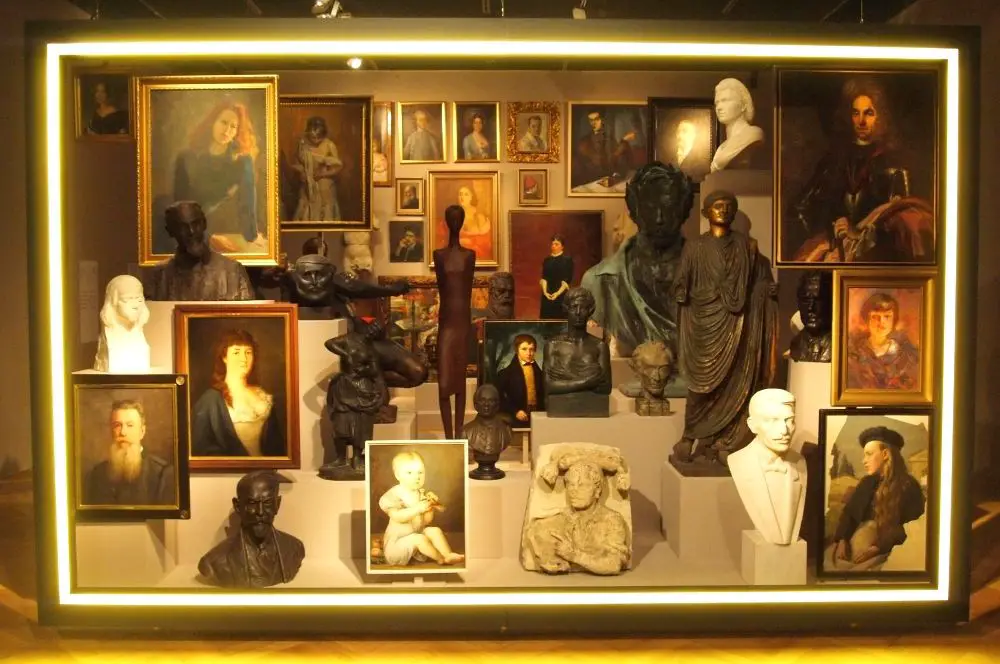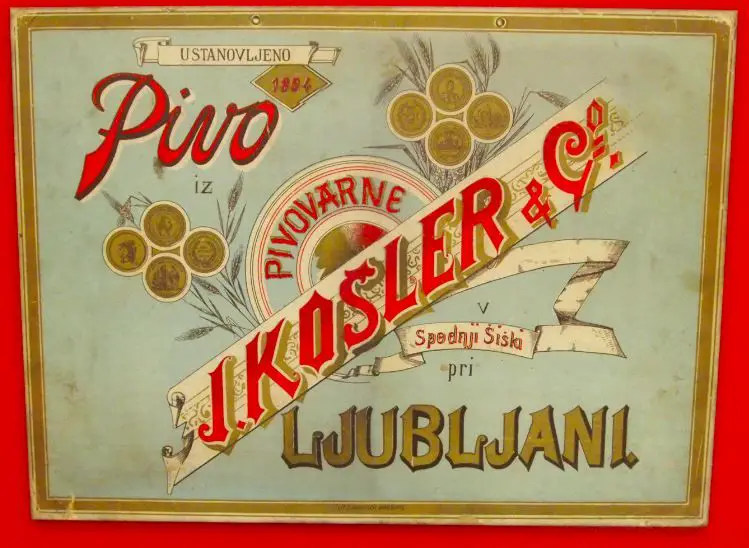Lifestyle
STA, 10 February 2019 - Slovenia was hit by a major ice storm in late January 2014. Lasting ten days and coating vast swathes of the country in thick glaze ice, the extreme weather event left deep scars on Slovenian forests that remain painfully visible.
Six million cubic metres of wood had to be felled as a direct consequence of the glaze ice, more than the typical annual nation-wide wood harvest, with an almost three million cubic metres more left to rot in forests.
The direct economic damage to forests has been estimated at EUR 214m, with total damages significantly higher, at EUR 429m, due to the destruction of rail, power and telecommunications infrastructure.
Infrastructure has been repaired, but forests remain scarred, having been additionally hit by a massive bark beetle outbreak in 2014-2018 that condemned over seven million cubic metres of spruce to felling, and a severe windthrow in late 2017.
The glaze ice destroyed mostly broadleaves and the bark beetle attack decimated spruce. Combined, these events have permanently altered the species composition of Slovenian forests.
Experts believe spruce, because of its economic importance the dominant tree species in the country, will be gradually supplanted by more robust species such as Douglas fir.
But this will merely accelerate the trend already precipitated by climate change, which is likely to drive spruce out of Slovenian forests in the long term, according to the Slovenia Forest Service.
Forest regeneration will not be left entirely to chance, though. While 27,000 hectares of forest has been severely affected by extreme weather, 1,200 hectares will be replanted artificially.
Foresters are planting around 20 species of trees depending on growing site, from spruce and beech to oak, maple, wild cherry, larch and fir.
The massive ice storm of 2014 is considered a once in a century event. "The likelihood of glaze ice across such a vast area is very small. It takes a combination of several conditions that is luckily very rare," meteorologist Brane Gregorčič says.
February 10, 2019
Read part one here and part two here.
The main task of the Slovenian Mountaineering Society (Slovensko Planinsko Društvo, SDP), established in 1893, was to build, take care and then walk along the secured mountain trails. One of the first important improvements on Triglav was securing some of the most problematic parts of the route leading to the summit. In the early 1870s, a local guide, Šest, and his son eased the trail from Triglav temple to Little Triglav, cut some very much needed steps into the rock, and secured the ridge between both peaks with iron poles with loops that carried a rope fence, which now allowed even more climbers to reach the summit.
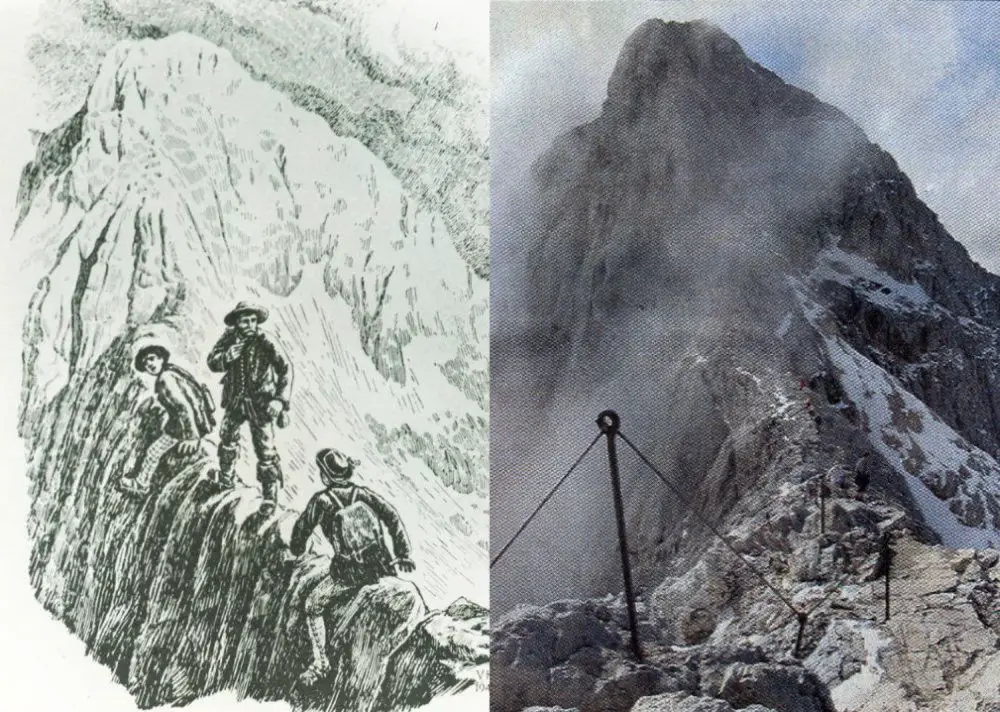
In the years that followed, more trails were built and secured, allowing the ascent to the summit from several huts in various directions, including from the north. This is a route which used to cross the shrinking glacier, but today leads to Kredarica, the most popular starting point to reach the summit since Jakob Aljaž found a great spot for a hut which was built there in 1896.
However, the Slovenian Mountaineering Society did little for a small group of daring young climbers, who were more interested in new routes than tourist walks on known and secured trails. On Triglav, this meant climbing the Northern Wall, one of the largest of its kind in the Eastern Alps. It's 1300m high (following the German route) and 3500m wide, with several shelves and ravines forming independent walls within the big one. Triglav’s Northern Wall is also home to several of the hardest climbing routes in the Slovenian Alps.
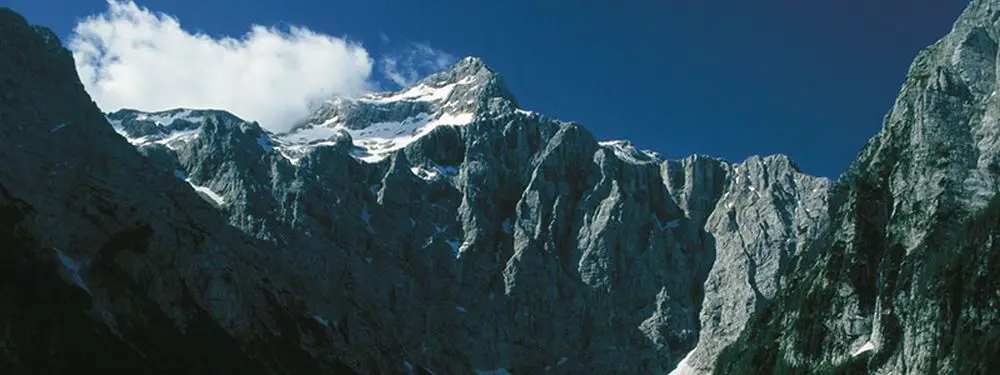
Triglav Northern Wall
Although the first climbers of the Northern Wall were shepherds and hunters, who mostly followed the paths of animals, sports climbing was based on a different kind of logic from that which found a path that was shown to a “gentleman” by a hunter, as the so-called Slovenian route across the Northern Wall was shown by a guide (Komac) to Henrik Tuma in 1910. If the new route for the older generation meant an easier path across a newly climbed slope, the new view on alpinism involved climbing a new, more difficult route without cleared paths and instead with the help of pitons and ropes.
Triglav’s Northern Wall was considered one of the three main problems of the Eastern Alps before it was even climbed, and as such was the focus of German, Austrian and Czech climbers. After the walls of Watzmann (1888) and Hochstadl (1905), the wall of Triglav was finally climbed by three Austrian Germans, Karl Domenigg, Felix Koenig and Hans Reinl, in 1906. The route has become known as the German route, and their success was immediately followed by several failed attempts, some even fatal ones.
Dren Society
In 1908 the Dren society was established, a group of students interested in Alpinism, skiing, caving and photography, novel activities outside the usually promoted Alpine tourism of the Slovenian Mountaineering Society, whose members considered them as “neck-breakers”.
Slovenian Alpinism before World War One was still way behind the developments in other parts of the Alps. The first use of a piton by a Dren member, Pavel Kunaver, is only recorded in 1911, which is also the last year of attempts at the Northern Wall until after the war.
Although Dren members did introduce some novelty into Slovenian climbing, such as winter ascents (sometimes accompanied by skiing) and other more adventurous climbs, their equipment and technique at the time only allowed them to climb routes of the third level of difficulty, and their predecessor and colleague Henrik Tuma hadn’t climbed anything beyond that level either.
This situation can be seen in the fact that the abovementioned German route on the Triglav Northern Wall, which had the climbing difficulty of level IV, was the most difficult route in Slovenian mountains at the time. Hans Reinly, one of the three first climbers described the achievement with the following words: “Triglav rises its triple head angrily. Let it be called Slovenian highest mountain, but this time it was the German force that conquered its most terrifying hip and fought through dark fogs which driven by a storm descent into the depth from the grey ice at the edge of the wall.” Worth mentioning is that in those days there was no meteorological report, and the day and a half climb took place in rain and bad weather.
The guiding ideas of the Dren were to conquer Slovenian mountains before the German mountaineers, try to prevent the Germanisation of Slovenian mountain names, and to climb without mountain guides, which was the main mountaineering style of the time. Lack of manpower and resources prevented these goals being fully achieved, although the ideas persisted throughout the interwar period and became perhaps the main reason behind the increasing Slovenian obsession with Alpinism, which eventually produced some of the best climbers in the world and continues to do so, regardless of the small the size of the place and its population.
Triglav in the Interwar period
After the war, and let’s not forget that one of the bloodiest WWI fronts took place right at Triglav National Park’s eastern border across the banks of the River Soča (the Battle of Isonzo), the main concern of the Slovenian Mountaineering Society was mostly fixing what had been damaged or destroyed.
Furthermore, the Austro-Hungarian Empire fell apart and Slovenia joined the newly formed Kingdom of Serbs, Croats and Slovenes. It turned out, however, that in 1915 the Triple Entente had signed a secret agreement with Italy, promising it large chunks of the Austro-Hungarian Empire in case of victory. With the 1920 Treaty of Rapallo Italy managed to claim most of the lands promised to her by the United Kingdom, Russia and France, which set the Italian-Yugoslav border at the peak of Triglav, a couple of metres away from Aljaž Tower.
Originally, the entire peak of Triglav was to belong to the Kingdom of South Slaves, however, Italy pushed very hard to get the land under its jurisdiction. The dispute was even more meaningful given that it was part of an attempt to extend poor conditions the Slovenes on the other side of the border had to endure in the face of the rising Italian fascism. The negotiations lasted for four years, and while waiting for the final decision certain incidents took place at the top of Triglav, in the summer of 1923 in particular. These are often referred to as “painting battles” but did in fact involve a more serious weapons beside the paintbrushes, which were used to paint Aljaž Tower with slogans and flag colours. Luckily, nobody got hurt, Aljaž Tower was eventually repainted to its original grey, and the final decision on the border in 1924 set the boundary marker 2.55m west from the Aljaž Tower, rendering the summit it effectively Slovenian.
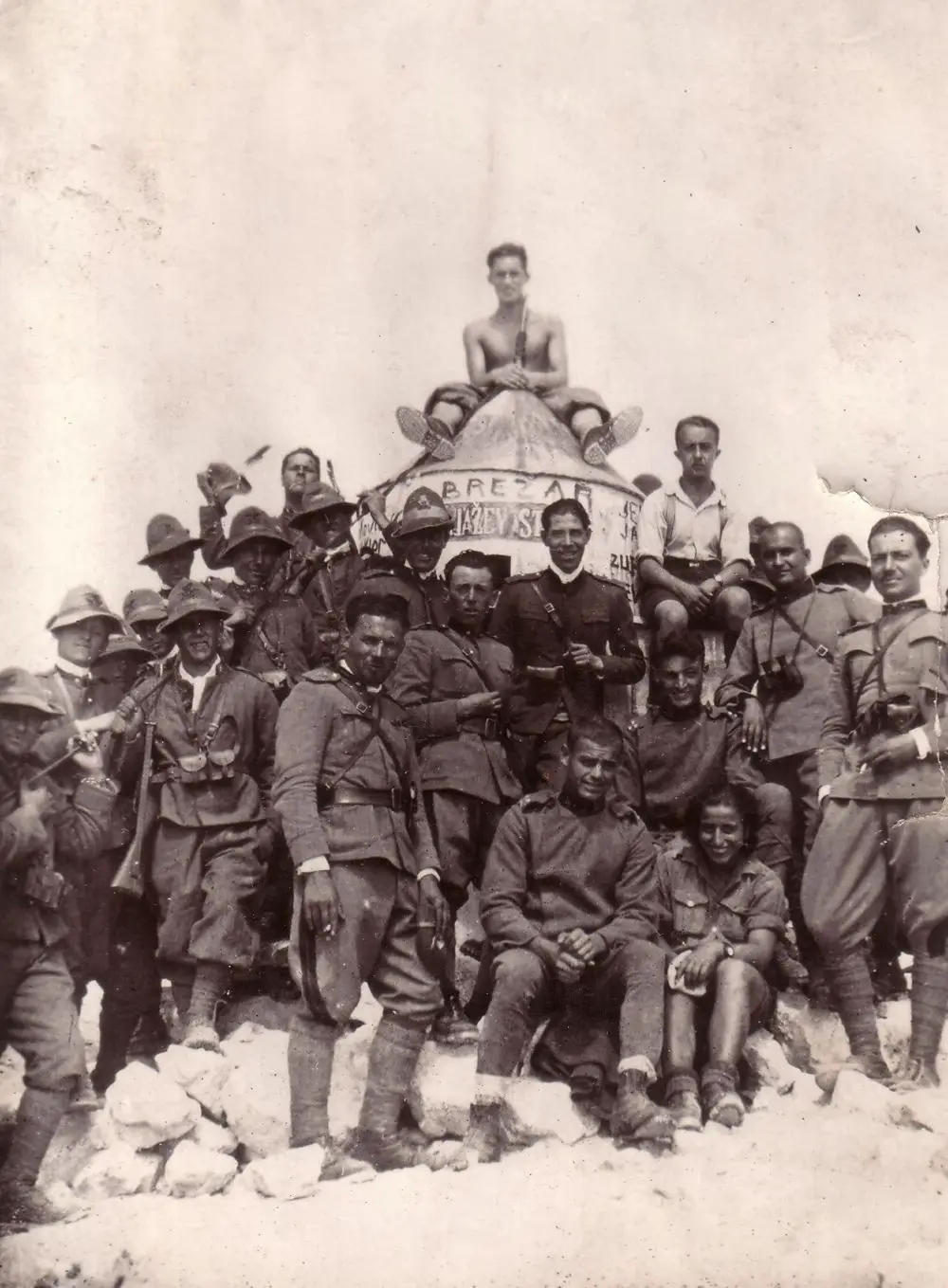
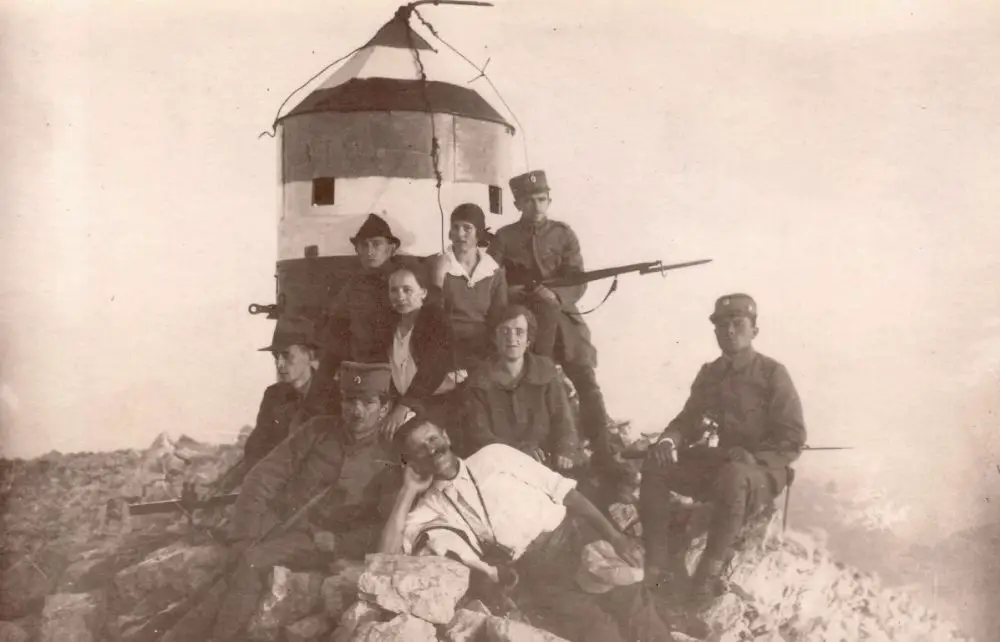
Tourist Club Skala
Within the Slovenian Mountaineering Society (SPD) friction between the moderates and those advocating for “steep tourism” continued into the interwar period. Since the majority of members would not allow sports climbing to be recognised within the SDP, young mountaineers splintered off into a Tourist Club Rock (Turistovski klub Skala, TK Skala) in the winter of 1921.
Rock’s main goal was to continue the development in sports climbing started by Henrik Tuma and evolved by the Dren Society. Among the important climbing achievements of TK Skala are the first Slovenian level V difficulty route climbed by a female climber, Mira Marko Debelak, in 1926 (at the north face of Špik), and the first fully successful winter climb of Triglav’s northern wall in 1939 by Beno Anderwald, Mirko Slapar, Bogdan Jordan and Cene Malovrh, who since 1934, when the SPD finally took alpinism under its wing, had also been members of this organisation.
Foremost, however, Skala’s important achievements also extended into the field of art and culture. Like Dren, TK Skala promoted mountain photography and established a special photography department in charge of postcard production and other images for propaganda purposes. But above all, they were responsible for the first Slovenian feature film, the 1931 V kraljestvu Zlatoroga (In the Kingdom of the Goldhorn) and partially also for the second one a year later, Triglavske Strmine (The Slopes of Triglav). The first movie was produced by Skala and directed by one of their members, Janko Ravnik, while the second was produced by an independent film studio, although it featured several mountaineers/actors from the first film, including Miha Potočnik and Jože Čop.
This week includes Valentine’s Day, Thursday, so be aware that some restaurants might be busier than usual that evening. Otherwise the streets should be relatively empty, so it’s a great time to explore the city without the crowds and be almost certain of a seat or a table wherever you are.
If you're not in town for the week of this guide (11-17 February, 2019) then you can see all the editions here, and you can enhance your stay in the city and impress or annoy friends and companions by learning some obscure facts about the city here, and the Castle here.
As ever, clicking on the venue names in the list below should get you more details with regard to the time, price and location, as well as other events on at this place in whatever week you're here. Finally, if there's something you want to promote in a future edition of What's on in Ljubljana please get in touch with me at flanner(at)total-slovenia-news.com
- Cinemas and films
- Clubbing
- Live music
- Opera, theatre and dance
- Harm reduction and drug testing
- Things to do with children
- LGBT+ Ljubljana
- Ljubljana Castle
- Museums and galleries
- Other things to do in Ljubljana
- Daytrips
- Getting around
Cinemas and films
You can read about all the cinemas in town here, while a selection of what’s playing this week is below, and note that kid’s movies tend to be shown in dubbed versions, so do check before driving out to a multiplex and dropping off the young ones if they can't understand Slovene. Parents should also pay attention to Kinobalon, which is Kinodvor's regular weekend series of film screenings for children, from babies on up, with special parent/child events, "first time in a cinema" screenings, and babysitting. Learn more about it here, and see the current schedule here.
A focal event for moviegoers this week is Kinodvor’s annual Retrosex evening of erotica to mark Valentines Day, and this year the celebration of sleaze takes place on Friday the 15th. It happens here because Kinodvor used to be Kino Sloga, which showed such material in the 1980s. Learn more, and see the trailers, here.
Kinodvor – In addition to Friday’s Retrosex event, see above, the arts cinema not far from the train station is showing, among other features, Green Book, Maria by Callas, Women at War, Beoning (in Korean with Slovene subtitles), Capharnaüm (in Arabic with Slovene subs) and Widows.
Kinoteka – This revival cinema isn’t far from Kinodvor, at the train station end of Miklošičeva, is showing Krótki film o zabijanju, Brutti, sporchi e cattivi, Melancholia, Il fiore delle mille e una note and Take Shelter.
Kolosej - The multiplex out at BTC City Mall is playing all the big movies, which this week include Papillion, Taksi bluz, Serenity, a dubbed version of How to Train Your Dragon: The Hidden World, Green Book, Vice, Mary Queen of Scots, Glass, The Mule, The Favourite, The Upside, Ralph Breaks the Internet: Wreck-It Ralph 2 (dubbed), Asterix: Le secret de la potion magique, Second Act, Južni veter, Aquaman, a dubbed version of Spider Man: Into the Spider-Verse, The Grinch, A Star is Born, Bohemian Rhapsody, and Escape Room. New this week are Lego Film 2, Cold Pursuit, Alita: Battle Angel, and Happy Death Day 2U.
Komuna – The cinema in a basement behind Nama department store is showing Green Book and Bohemian Rhapsody, while from Thursday on you can see Qu'est-ce qu'on a encore fait au bon Dieu?
Clubbing
Compared to some European capitals it can seem that nightlife in Ljubljana ends rather early, especially along the river, but there are still bars that stay open late and clubs were you can dance until dawn, and perhaps the best place to stumble across something interesting is the legendary Metelkova. Be aware it's a grungy kind of place and not for all tastes, but also that there's considerable variety to found within the various clubs there, from death metal to electropop, gay cabaret to art noise. You can read "the rules" of the place here.
Božidar - Friday night it’s Stiropor pres.: ADAM X (Sonic Groove, LIES / USA) playing techno and industrial, with support from Schrauff Elements.
Channel Zero – Friday there’s SUBØ: Bojler x SNIF w/ Merca Bae, with sounds from MERCA BAE (ES), Dvmir b2b KMN, Futon b2b Lil Ris, Novack and TMA, with visual support from SMECH. It seems to be a bass-heavy dancehall club event, with a set from Merca Bae below.
Klub Cirkus – Friday the more commercial end of clubland offers an all-nighter with TRIP ft. Joe2Shine (DJ Mag Top 100 club Revelin / Ultra Europe). Saturday it’s the turn of Best of RNB.
Klub K4 – Friday the klub for kool kids has K4X4 w/ Roza Terenzi playing “dance” provided by DJs Roza Terenzi (Planet Euphorique, AU), Nitz Live! (Synaptic), Softskinson (Sezam), Stasša, Vuka and Disco Durum. Saturday the all-night fun will be provided by Temnica, with Octex (live/dj), Organon (Elements) and Rokko (JustJam).
Orto Bar – Friday night this rock club will swap guitars for turntables, with Orto 90s Hit Mix Vol.1. No further details are given, or perhaps needed.
Live music
Cankerjev dom – Tuesday, the 12th, the country’s main arts venue will host Baptiste-Florian Marle-Ouvrard, who’ll be playing the organ in a show called The Infinite Expanses of Improvisation. “A daring musician, he combines organ with other forms of artistic expression, including dance, electronic music and graphic art.” The programme will include Bach and Stravinsky. The same evening you can enjoy another in the series of concerts curated by John Zorn, with Ikue Mori presenting an audio-visual solo show.
Gala Hala – Live rap is then followed by DJ sets, with Rapetek Extra: Homeboy Sandman & Edan (ZDA), followed by DJs K’Pow and Borka.
Jazz Club Gajo – Jazz Paradise (Slovenska cesta 58) has a Valentine’s concert with Nina Strnad and the jazz trio Lenart Krečič and Gregor Ftičar.
Festival Hall (Vilharjeva cesta 11) – The Embassy of the Islamic Republic of Iran is presenting a free concert by The Darvag Band.
Kino Šiška – Thursday evening there’s live music from American-British quartet Algiers, a band which “has been confronting the forces of political apathy, fascism and social injustice head on with its unpredictable blend of post-punk anger, noise savagery and gospel soul.”
Križanke – The venue that hosts the Ljubljana Festival has a free concert on Thursday, the 14th, with Kjoka Macujama (violin), Milana Černjavska (piano) and Maja Vrbnjak (guitar), playing Schubert and others.
Ljubljana Castle – Friday is jazz night at the Castle, with that often stretching to rock and funk, and this week it’s Nermin Puškar.
Orto Bar – Wednesday evening presents the opportunity to enjoy some mid-week metal at this guitar-friendly venue, with the stage being owned by an all Australian bill of Aversions Crown, Psycroptic, Hadal Maw, and Hollow World. Thursday, Valentine’s Day, it’s the turn of one of Slovenia’s hottest young bands, Koala Voice, who will be presenting their third album, Woo Horsie. Saturday a slightly older crew takes over, with Leteči Potepuhi. The show’s being promoted with their 2009 video for Jedrt, as seen further down.
Opera, theatre and dance
Gledališče IGLU - IGLU Theatre – Saturday night this group is usually putting on an English improv show somewhere in town, but it’s generally promoted after this is written, so check the Facebook before putting on your shoes.
Mini Teater Ljubljana – The English schedule of varied performances for the month is here.
SNG Opera and Ballet – Smetena’s The Bartered Bride will be performed at 19:30 on the 12th, 14th and 16th (Tuesday, Thursday and Saturday). The programme also has Bizet’s Carmen on Saturday, 19:30. A clip from an earlier production is below.
Harm reduction and drug testing
Drogart is an organization that aims to minimise harm on the party scene, and offers drug-testing services and reports on their webpage. It’s in Slovene, but you can Google translate it or work things out yourself, and our story on the group is here. They recently published a story warning about three pills with very high contents of MDMA, with details (in Slovene) here. Also be aware that all the usual drugs are illegal in Slovenia.
Things to do with children
You can find our Top 12 list of things to do with kids in Ljubljana here. If want to read more about the philosophy behind the wonderful House of Experiments look here, while our trip to the Museum of Illusions is documented here, and there’s always riverside walks, pizza and ice cream. With regard to the latter, take a look at our guide to six places that serve good ice cream in winter.
Mini Teater Ljubljana – The season sees a lot of puppet performances for children, in Slovene, at this theatre not far from Križanke. The English schedule for the month is here.
Ljubljana Puppet Theatre - The puppet theatre near the Central Market and next to the Castle funicular has a full programme or shows, for children and adults, with the schedule here.
LGBT+ Ljubljana
If you want to learn more about Ljubljana Pride, then take a look at our interview with its president here. If you're looking for more general links on "gay Slovenia", including a history of the scene and various projects, then you can find that here, while our stories about the community can be found here.
Klub Monokel – This lesbian bar in Metelkova is open every Friday
Klub Tiffany – And the gay bar next door is also open on Fridays, while every Monday until June 2019 there's tango at 18:00.
Pritličje – This seems to be the only "always open" LGBT-friendly cafe / bar / events space in town, and perhaps the country, so it's a good thing it's such a good one, open from morning to night, and with fliers and posters letting you know what's happening outside the narrow confines of, say, a general interest online what's on... guide.
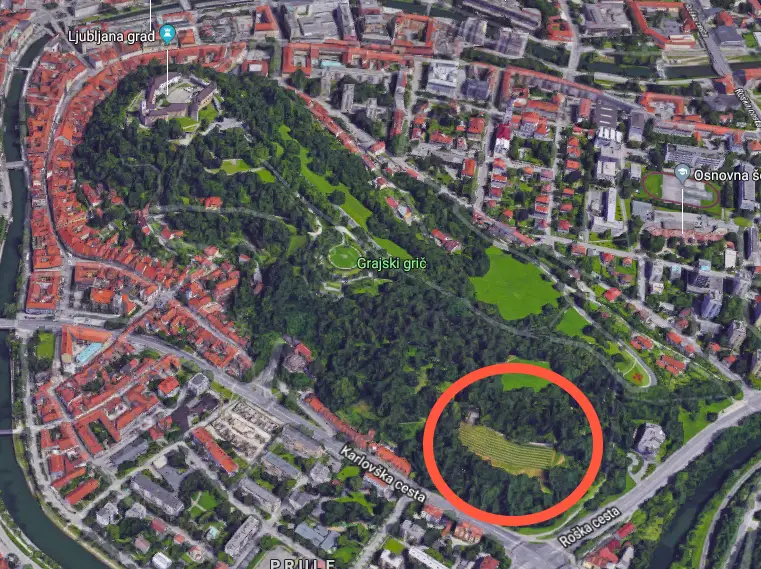
Screenshot from Google Maps, showing the location of the Castle vineyard
Ljubljana Castle
The city’s main attraction is said to be the top tourist draw in the country overall, and to my mind it earns a spot near the top just for the history and views. But beyond that the current owners, the City of Ljubljana, have laid out a varied, interesting and enjoyable programme of events, one that rewards regular revisits.
I try and get up there every Saturday morning to clear my head and move my feet on the trails, and never tire of that end of the hill. At the other end, where the Castle sits, there’s a lot more than fresh air on offer. There are guided tours, restaurants, a café, Castle museum, puppet museum, a Watchtower you can climb to the highest point in the city, art shows, dances, live music, movies under the stars, festival days and more – enough to reward multiple trips up the hill through the year. All of these activities and events can be found on the Castle website, while on TSN you can see “25 things to know about Ljubljana Castle” here, and “Ten Ways to Enjoy Ljubljana Castle” here.
Museums & Galleries
Most public galleries and museums are closed on Mondays, although not the National Museum, and - as noted at the start
Plečnik's desk. Photo: JL Flanner
Plečnik’s House is worth a visit if you want to learn more about the architect who gave Ljubljana much of its character. Read about our guided tour here.
Cankerjev dom – On until February 28 is the exhibition Ivan Cankar and Europe, Between Shakespeare and Kafka, while until March 10 there’s a photographic show on the Ljubljanica, with images of the city’s river captured by Bojan Velikonja. Showing until the end of March is a selection of specimens from The Newspaper Museum.
City Museum – The Museum in French Revolution Square also has an exhibition on the writer Ivan Cankar that’s on until the end of February 2019, with pictures, books and manuscripts, all presented in Slovene and English. It also has a very interesting permanent exhibition on the history of Ljubljana, from prehistoric times to the present day, with many artefacts, models and so on that bring the story alive.You can read about my visit here. Until March 2019 there's a show highlighting the work Elza Kastl Obereigner (1884-1973), a pioneer Slovenian sculptress, with an example of her work shown below.
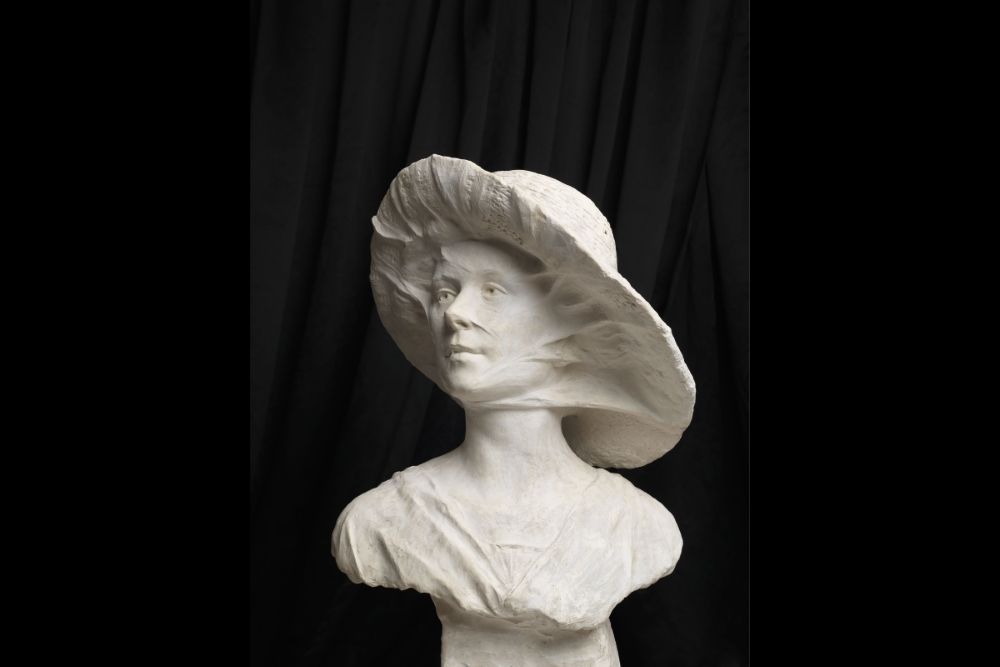
Photo: M Paternoster
The Faces of Ljubljana in the City Museum. Photo: JL Flanner
Galerija Jakopič – On until March 3 is Over My Eyes (Na moje oči), an exhibition of photographs from Iraq taken by Iraqi photographers.
International Centre of Graphic Arts – Running from Friday until March 3 2019 there will be a show of posters from Milton Glaser, while paintings, drawings, prints and from Nathalie Du Pasquier in a show called Fair Game. The latter is being promoted with the following image.
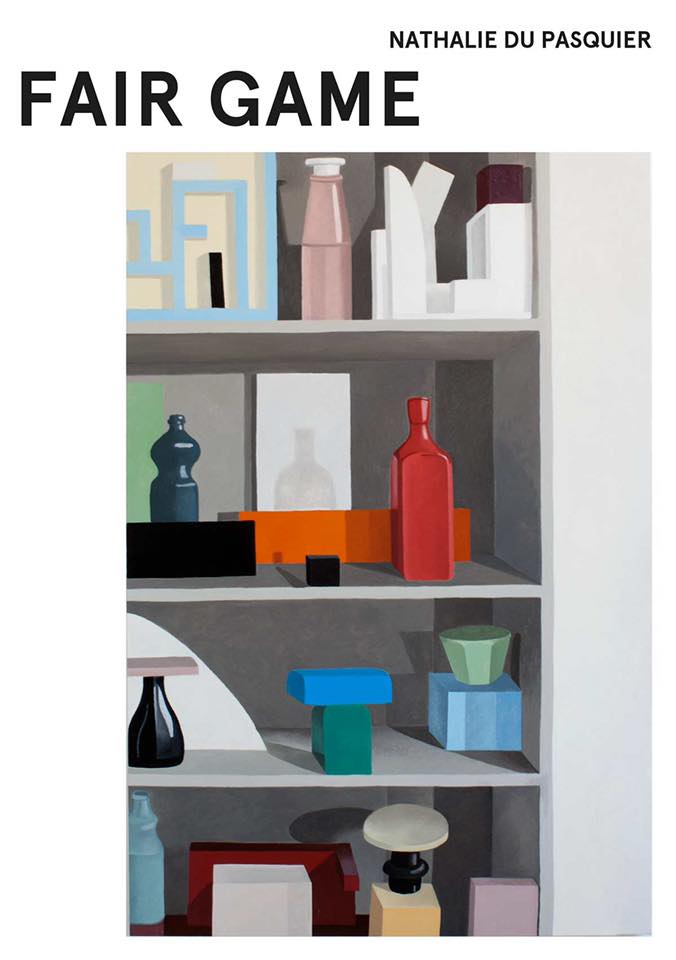
MAO – The Museum of Architecture and Design has much of what you'd expect, and until March 25, 2019, has a show on Ljubljana and it's relation with water. Until February 24 visitors can enjoy Toasted Furniture, which presents some experiments with the reuse of plastic waste, and until February 28 there's a show on Oskar Kogoj and his chairs.
Moderna galerija – The main branch of this gallery, to be found near the entrance to Tivoli Park, has a good collection of modern art, as well a nice café in the basement. Running until March 31 is a major show on young Slovenian painters, Time Without Innocence – Recent Painting in Slovenia, where you’ll see works like the following. You can read about my visit here (I loved it).
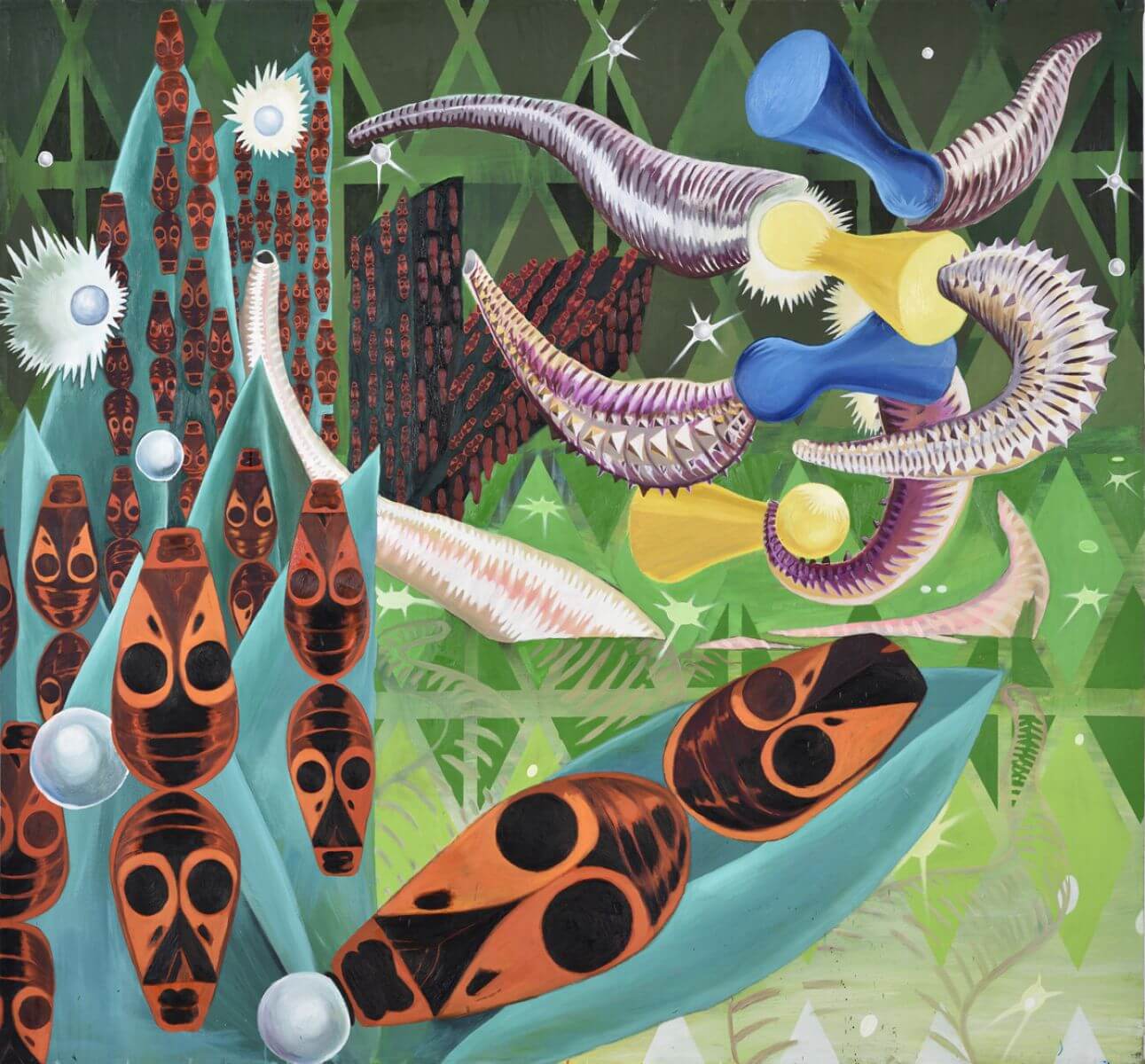
Iva Tratnik, Mating Season Totalitarianism, 2014, oil on canvas, 210 x 194 cm
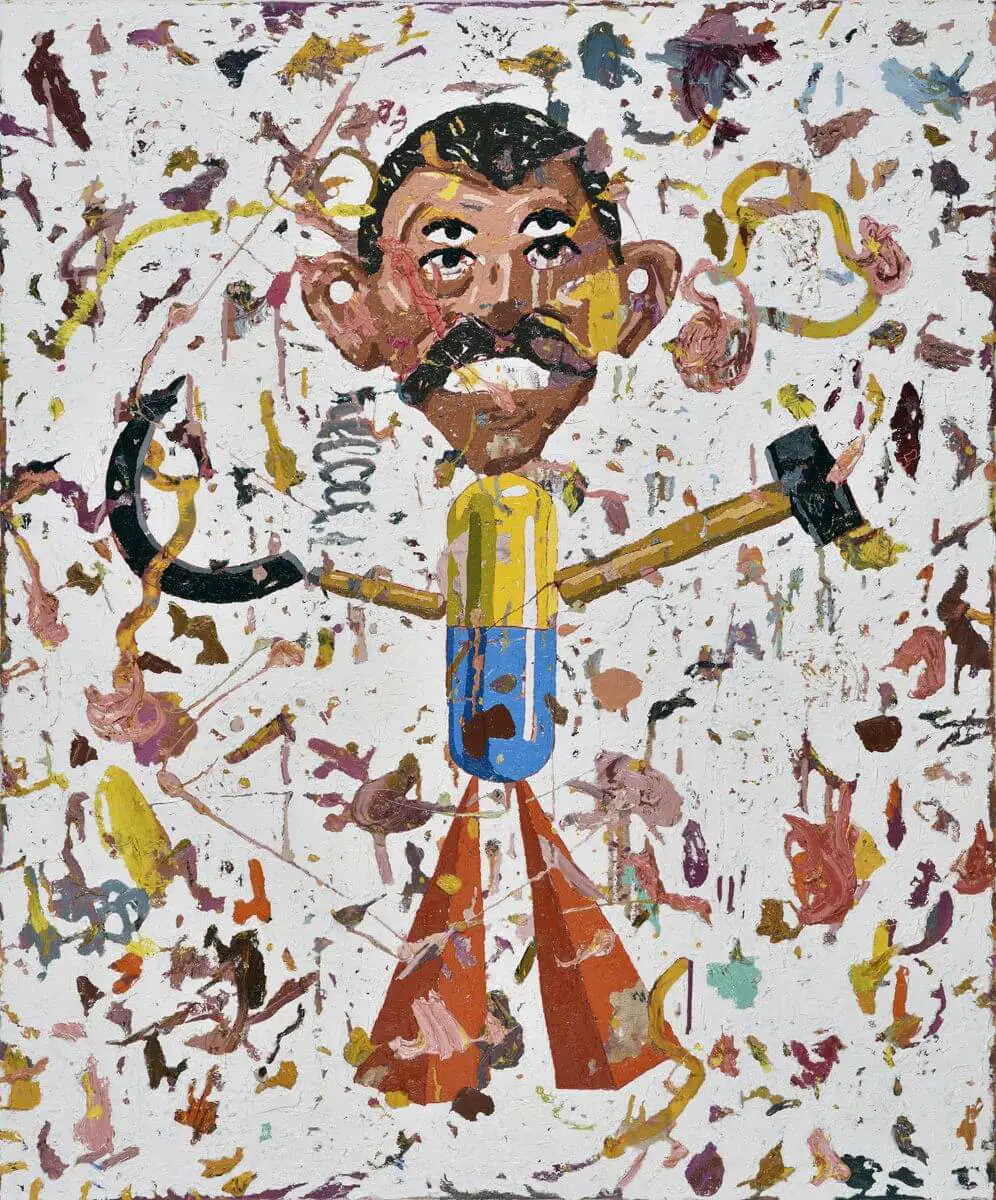
Arjan Pregl, from the Carnival series, oil on canvas (6 paintings 120 x 100 cm; 3 paintings 80 x 60 cm), 2018
National Gallery – The country’s main gallery has “the best” of what’s on offer from the Middle Ages to non-contemporary modern visual arts, and is in a great location for exploring other areas, just by Tivoli Park and opposite the main branch of the Moderna galerija. You can read about our visit to the room containing sacred art from the Middle Ages here.
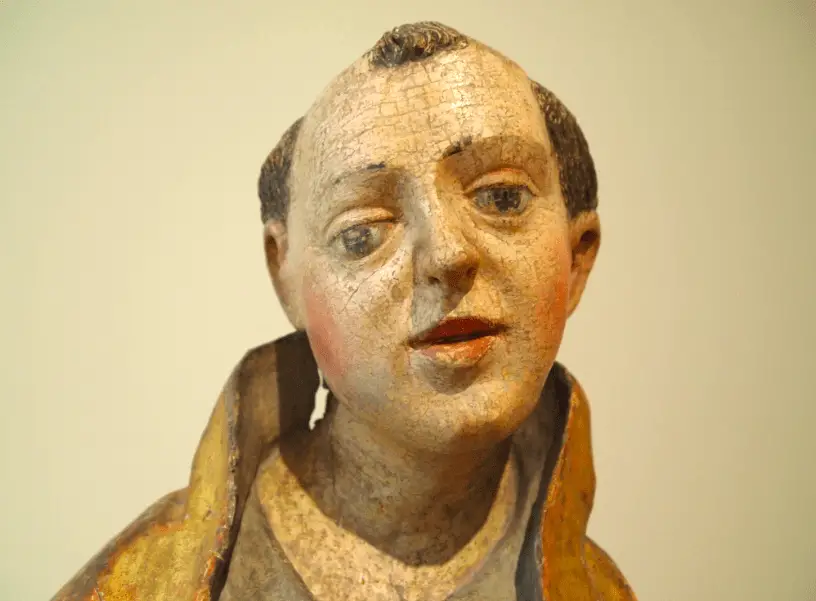
JL Flanner
The real Robba Fountain can be found in the entrance to the National Gallery - the one you see in the Old Town is a genuine fake, as seen below and reported here.
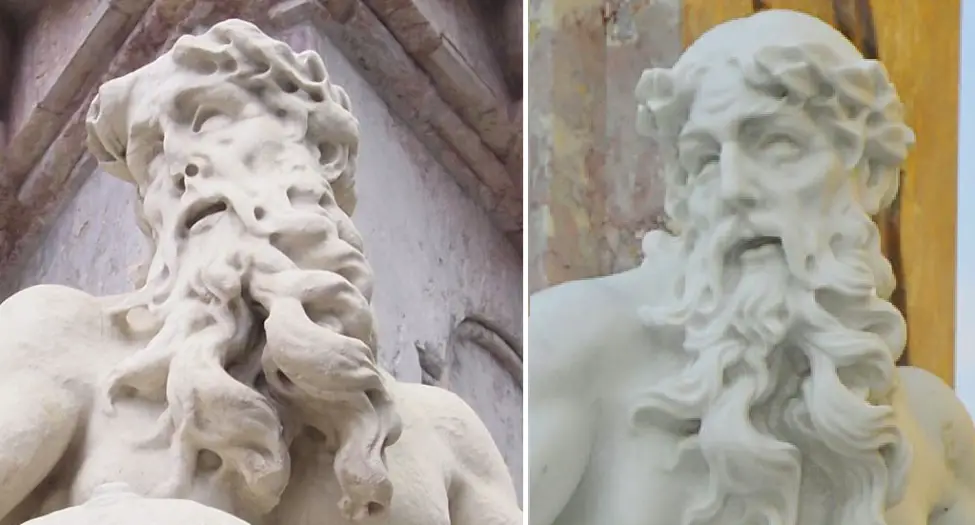
Photo: JL Flanner
National Museum of Slovenia – There’s plenty to see in the permanent collection here, from Roman times, Egypt and more, with the big draw this season being the exhibition of over 140 items of gold from Ming Dynasty China, as reported here, and with an example below. This runs until February 15th.
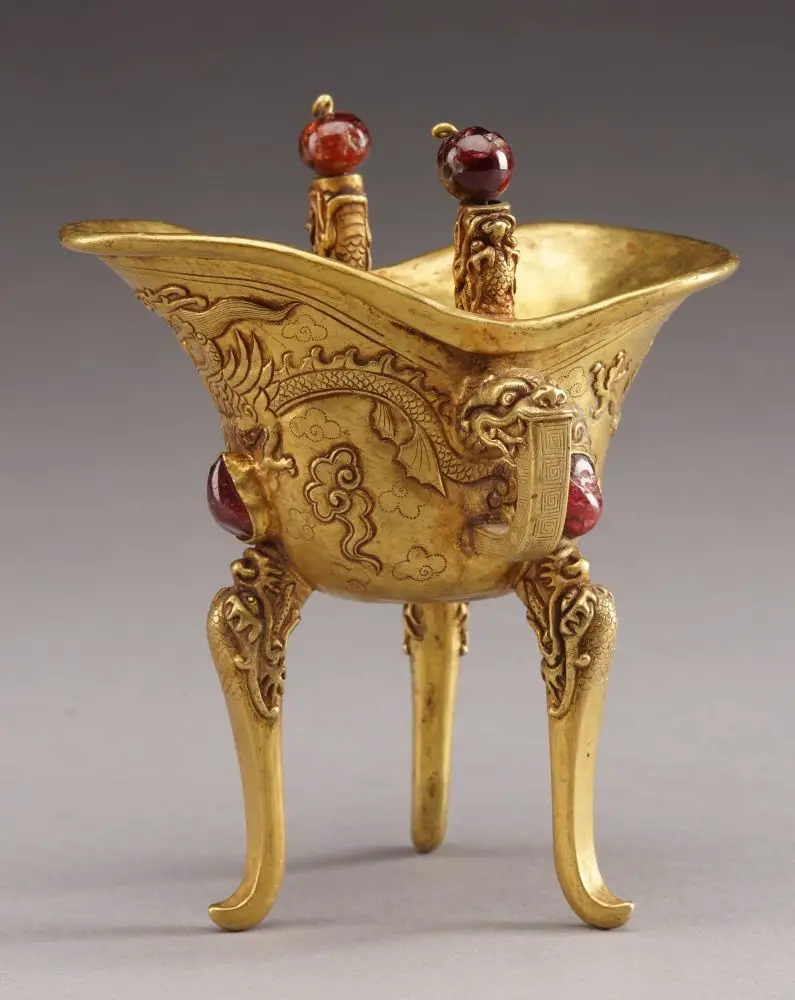
Photo: Wang Wei Chang
Meanwhile, the museum's Metelkova branch, located between one branch of the Moderna galerija and the Ethnographic Museum has some rooms on Church art, furniture and weapons, with the latter including more guns than you'll see anywhere else in town, and quite a thrill if coming from a nation where such objects are not household items.
Natural History Museum – On until the end of June 2019 is Our Little Big Sea, which takes a look at the oceans.
Slovene Ethnographic Museum – The museum currently has a temporary show on Bees and Beekeeping, on until June 16 2019, as well two permanent exhibitions. One of these is called Between Nature and Culture, and has a great collection of objects from Slovenia and around the world, well worth the trip up to the third floor to see it (as recounted here). This place is located near the newer branch of the Moderna galerija and Metelkova.
Union is "the Ljubljana beer", but now both it and Laško are owned by Heineken. There are many local brews on offer around town, though, if you want to explore IPAs, stouts, wheatbeers, sours and so on Photo: JL Flanner
Union Experience – The Ljubljana-based brewer has a museum showing the history of the company, with the ticket also including access to part of the factory and a few samples of the product. You can read about our visit here.
It's not a formal museum, but if you're interested in "Yugo-stalgia" then you'll enjoy a trip to Verba, a small, privately run space that's crammed with objects and pop culture items from the era, and is conveniently located at the start of one of the short walks to the castle. It's also a great place to take pictures, if you leave a donation, and you can read more about it here.
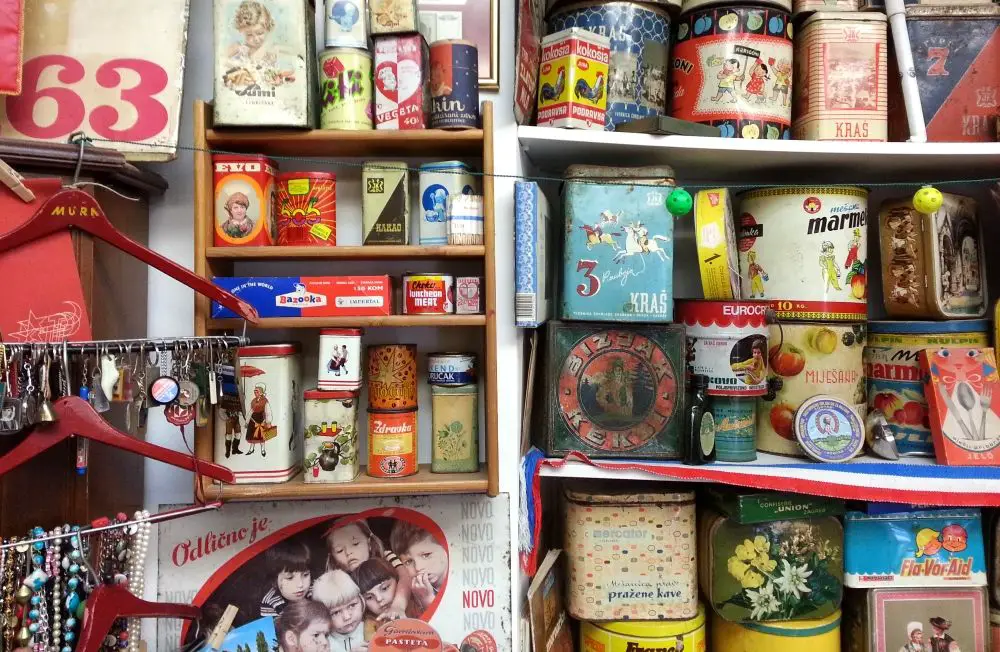
Verba. Photo: JL Flanner
Alternative Ljubljana isn't a museum or gallery, as such, but instead turns the city streets into a museum and gallery. Learn more about their tours of street art, history and LGBT Ljubljana here.
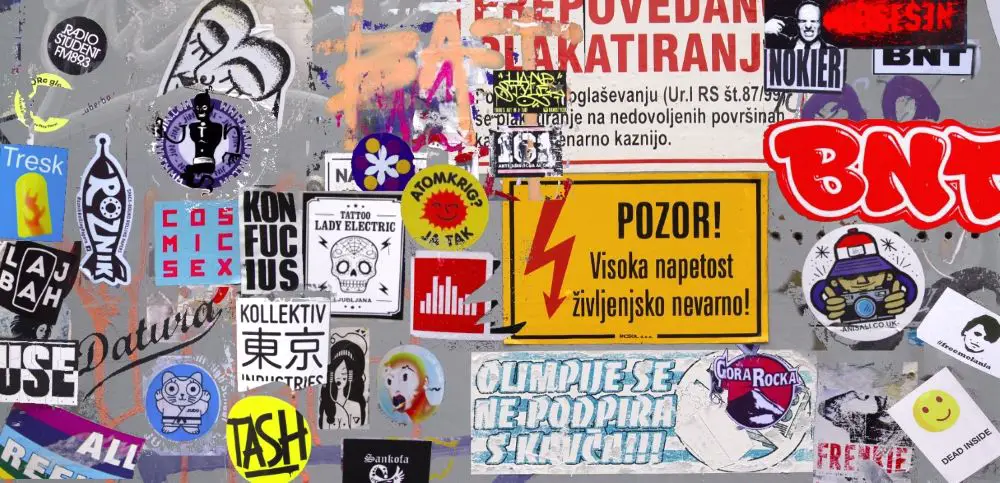
Photo: JL Flanner
Other things to do in Ljubljana
If you'd like to spend an evening painting with others, then take a look at Design with Wine, which organises painting parties on Trubarjeva cesta,
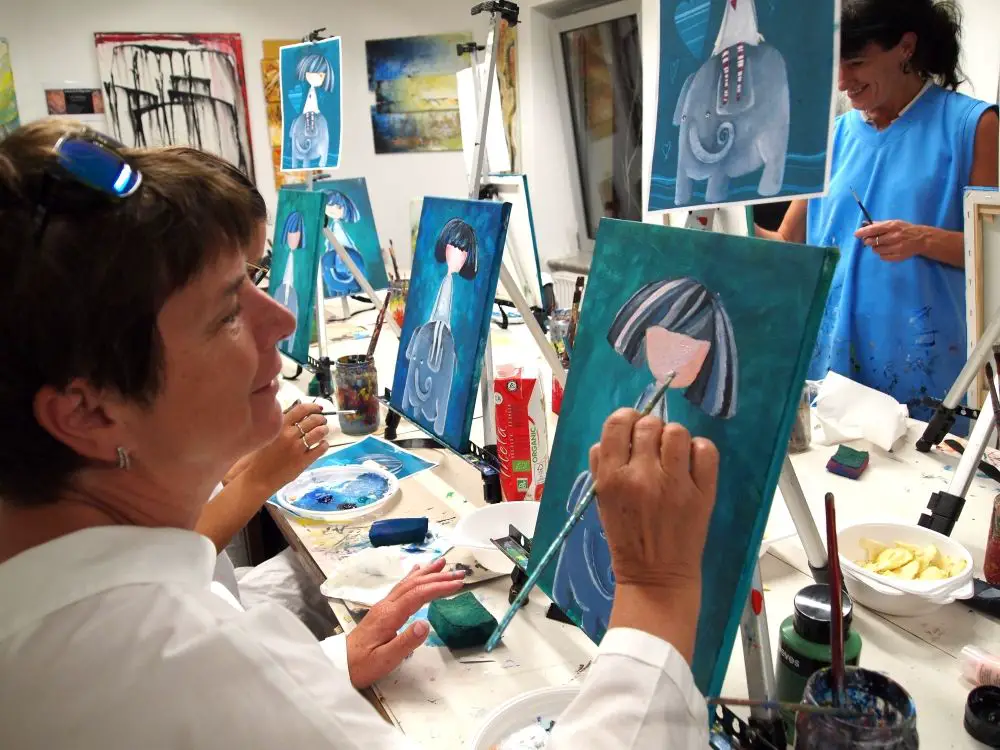
If you want to see some antiques, then check out the wonderful Antika Carniola, as discussed here. The man behind it, Jaka Prijatelj, has a fine eye for life on this street, as you can see on his Facebook account.
Photo: JL Flanner
If you’re in town and want to go jogging or walking in nature, why not take another look at the Castle, with a brief guide to the trails here. If you want something bigger, head to Tivoli Park.
And if you're bored with the Old Town, why not take a walk, cycle or boat ride to nearby Špica and enjoy the riverside life. Learn more about that here.
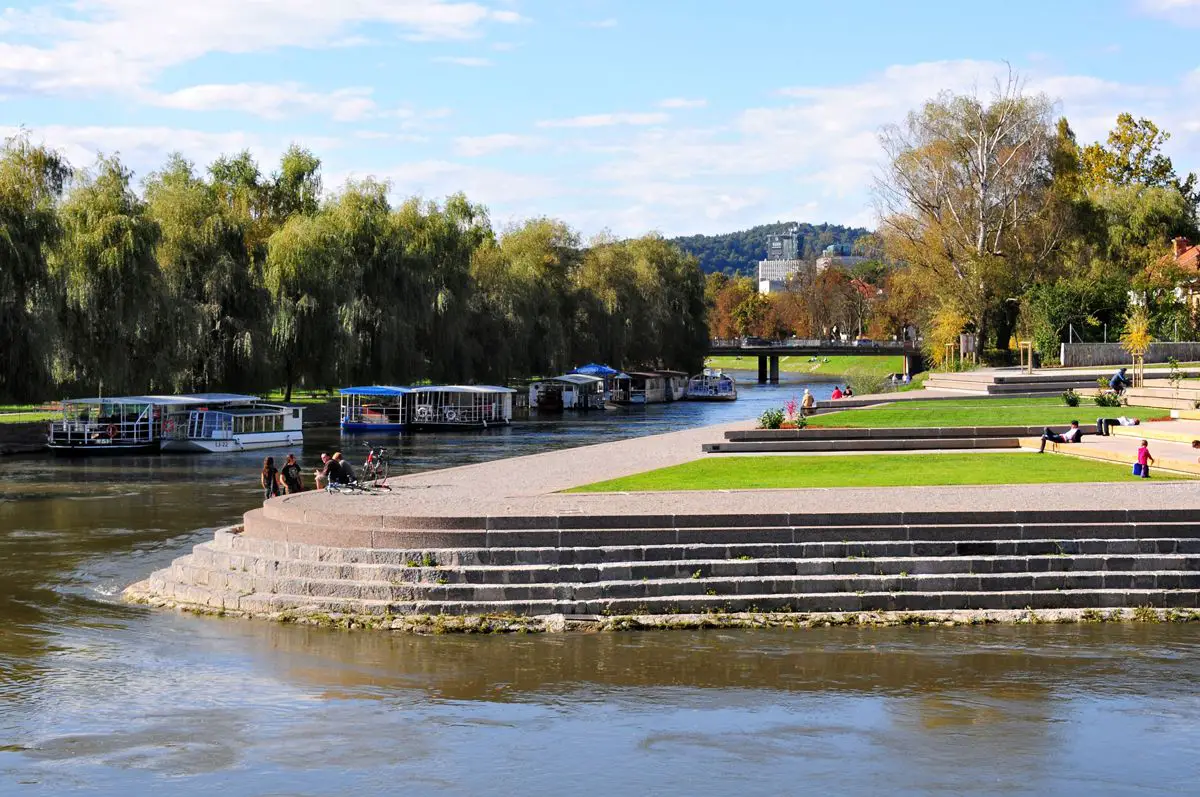
visitljubjana.si
![]()
maxpixel.net, public domain
Want to stretch and breath? Then check out our list of drop-in yoga classes for tourists, visitors and the uncommitted. If you're heading to the coast, check out our interview with a yoga teacher who offers breakfast sessions there, while if you're staying in town (or nearby) and want to try some "family yoga" then you can learn more about that here and maybe get your kids to calm down a moment or two.
There are some golf courses near Ljubljana, but even ones further away are not far, as seen in our list of all the golf courses in Slovenia. Note that these close when the snow starts, if it ever does this year, in which case you might be interested in what's new at Slovenia's ski resorts for 2019, as reported here.
![]()
Photo: maxpixel.net, public domain
Daytrips
Most of Slovenia is only a few hours from Ljubljana, and you can easily visit Lake Bled, Lipica Stud Farm, Postojna Cave, Predjama Castle, the coast and other locations, while if you'd like to take a photo of from that bench in Bled, then you can learn how to get there here. If you’re looking for something more ambitious, then check out our recent guide to the 17 members of the Association of Historical Towns of Slovenia
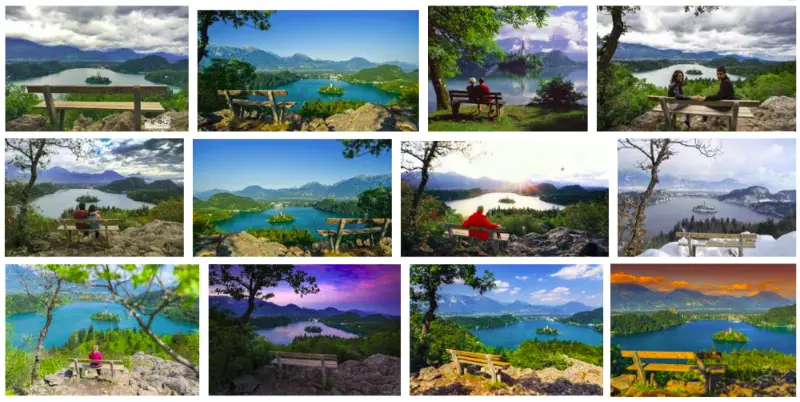
Photo: Google Image Search
Getting around
If you want to get a Ljubljana Tourist Card, which gives you travel on the city buses and entry to a lot of attractions, then you can read more about that here, and if you want to use the bike share system, as useful for visitors as it is for residents, then you can learn more by clicking this. Visitors with reduced mobility will be pleased to find that downtown Ljubljana is generally rated as good with regard to accessibility, and that there’s a free, city-sponsored app called Ljubljana by Wheelchair highlighting cafés, attractions and so on with ramps, disabled bathrooms and Eurokey facilities, which you can read about and download here. Manual wheelchair users can also borrow, for free, an attachment that will motorise their equipment, as reported here.
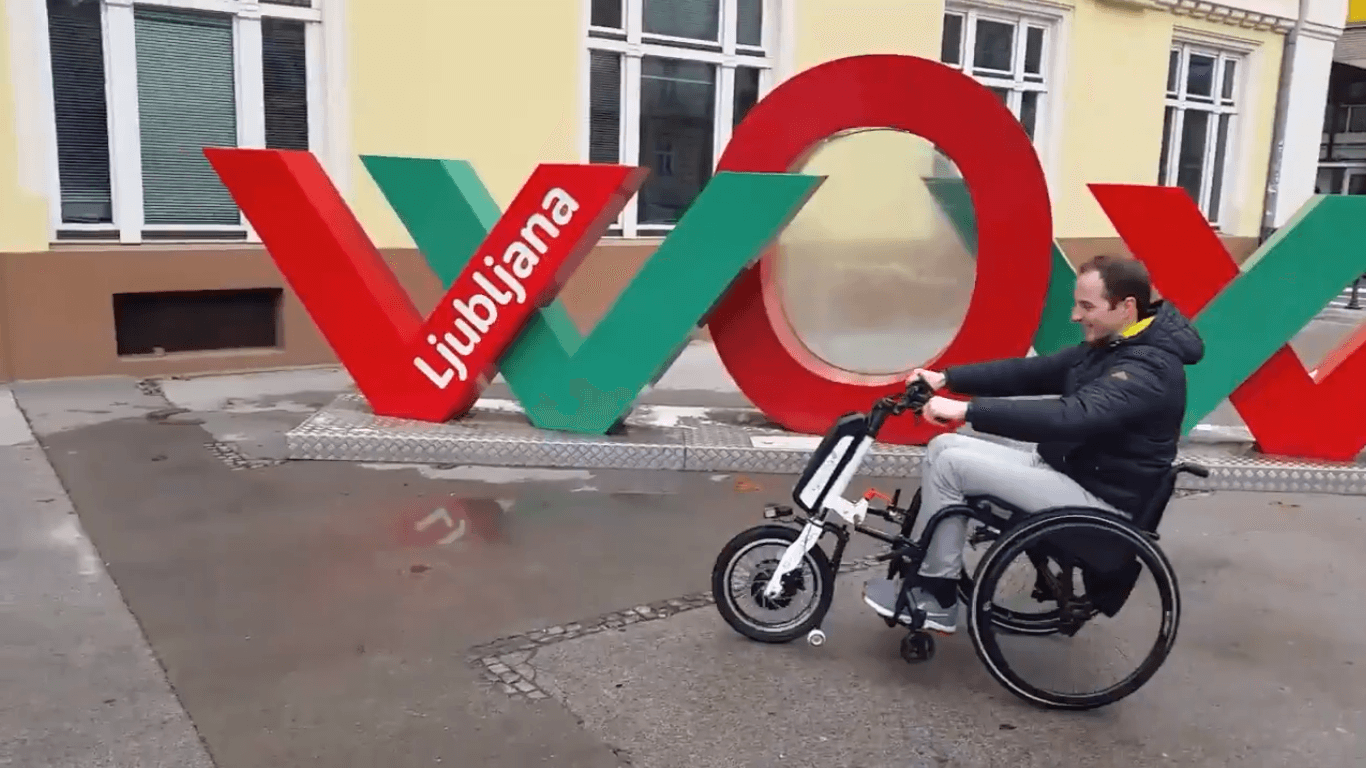
Screenshot from a Twitter video
If you’re driving into town and don’t know where to part, our guide to how to park in Ljubljana is here.
There aren't many places to eat after midnight, and most of them are by the train station, as reported here.
Want / need cigarettes but the stores have closed? Here's an incomplete list of bars downtown that will satisfy your craving for the demon weed. While if you’re having trouble with the ATMs then here’s a guide to the Slovene you’ll see on screen. If you get a hangover then find out where to get paracetamol (and prescription drugs) in Ljubljana here, while details on emergency birth control can be found here.
Ljubljana is a small and relatively safe city, but if need to contact the police then there’s a special number for foreigners, and that’s 113.
Kinoteka and Kinodvor are the places for discerning cinephiles in Ljubljana, where you can find folk who know their auteur from their mise-en-scène, their Louise Brooks from Brooke Shields, and Paul Thomas Anderson from Paul WS Anderson. The two places are perfect complements, to each other and the multiplexes out at BTC, together covering the whole range of cinematic arts.
Related: What’s on in Ljubljana this Week (including the current movies and trailers)
While Kinodvor keeps up with recent releases in terms of art movies and world cinema, Kinoteka delves deep into the back catalogue to present retrospectives and binge watching opportunities for fans of, say, Polish cinema, experimental shorts, Ingmar Bergman or Agnès Varda.
But you came here for the sex, not the art, and to learn more about the annual event when Kinodvor marks Valentine’s Day and takes up the spirit of Kino Sloga, or “the cinema that saw too much” ("Kino, ki je preveč videl") in the title of a documentary about the theatre that specialised in erotic movies in the last decade of Yugoslavia.
This year the adventurous can enjoy a varied programme on Friday, February 15th, that ranges from stag films to Oshima’s infamous In the Realm of the Senses (Ai No Corrida), starting at 19:00, although non-Japanese speakers should note that the subtitles will be in Slovene. Also on the bill are Sylvester Stallone’s early appearance in a sex movie (21:30), and an Italian language documentary about Valentina Nappi (23:15), who the Internet tells me is a pornstar. At the end of the evening there’ll be music from DJ Links. Relatively tame trailers for all three features can be seen below.
The Party at Kitty and Stud's, aka The Italian Stallion (per IMDB “Kitty and Stud are lovers. They enjoy a robust sex-life, which includes fellatio and light S&M, specifically, Stud belt-whipping Kitty. Three women come over for a party and Stud services them, one after the other.”)
As is often the case with such movies, IMDB’s Parents Guide is a fine summary of what emotions to expect, and whether you choose to experience them, as seen in this list of potential issues with Ai No Corrida
“I don't have any role models. I would like to do porn just as Maradona played soccer.” Valentina Nappi
Tickets for a single screening are €5.30 ( € 4.50 for members of the Kinodvor Club, those of over 60, students, students and the unemployed), and there’s also a "hardcore fan" package for all three shows: €13 (€10 for Kinodvor Club members), although note the number of these is strictly limited to 69.
You can learn more at the official page here, while Kinodvor can be found at Kolodvorska ulica 13, 1000 Ljubljana.
February 7, 2019
In 1942 the underground anti-fascist Radio Kričač (Radio Screamer) broadcast its longest and also the only cultural show of this kind in Europe.
On the eve of Prešeren's death, which is celebrated every February 8th as a day for culture and national holiday in the Republic of Slovenia, Radio Kričač broadcast a show that took about a month to prepare and involved recitals, music, speeches and other messages. Its usual programme would otherwise last 15 minutes three times a week.
Radio Screamer, established by members of the Liberation Front (OF – Osvobodilna fronta) operated from various secret locations in Ljubljana between November 1941 until April 1942, when it lost its audience following the Italian order for all the radio antennas to be removed from the city.
STA, 7 February 2019 - There are currently 646 people with refugee status in Slovenia. They are housed in integration houses or private accommodations, 99 of them are living abroad. A total of 109 are enrolled in schools, while around 100 refugees have already found a job.
According to the Government Office for the Support and Integration of Migrants (Urad Vlade Republike Slovenije za oskrbo in integracijo migrantov), the majority of refugees are citizens of Syria, Eritrea, and Iran, followed by the citizens of the former Yugoslav republics. They are entitled to financial compensation for private accommodation, integration assistance, employment, health and social care, and education.
Integration assistance is available for three years after gaining an international protection status and is provided by integration consultants at the office and non-governmental organizations.
The refugees attend integration assistance courses, such as the one conducted by Odnos association that supports them in finding employment, opening a bank account or submitting applications.
The refugees are also included in 300-hour Slovenian language courses, which can be extended. The office covers the costs of a one-time language proficiency test as well.
Related: Meet the People - Zana Fabjan Blažič, Organiser & DJ, Ambasada Rog
When it comes to employment, refugees are equal to Slovenian citizens, therefore having free access to the labour market. The Employment Service also conducts a course on integration into the labour market. According to the Office, there is no accurate data on the number of refugee employees, but they estimate that approximately 100 of them have jobs.
Among the refugees there are 184 children or minors, 12 are unaccompanied minors who are housed in boarding schools. Of the 109 enrolled in educational institutions, most are in primary school and 17 attend university.
STA, 6 February 2019 - Microbiological tests for a batch of kebab meat preparation delivered to Slovenia from Poland have come out positive for salmonella, the Food Safety Administration announced on Wednesday, adding it had ordered the tainted product to be pulled out and destroyed.
Two samples tested positive for salmonella. One was from a shipment of about one tonne of meat preparation produced in Poland on 13 December and supplied to Slovenia on 18 December.
The product was made by Polish company Dunya Doner kebab. Its distributor in Slovenia, Dunya kebab still held 490 kilos of the preparation when samples were taken on 1 February.
The other positive sample was from a batch produced on 19 December by Polish Efes-pol Fedai Simsek Sp.Zoo and distributed in Slovenia by Alebon. The 175-kilo batch arrived in Slovenia on 9 January.
"Recall and withdrawal of the product is under way as we speak. This means that the subject that puts the preparation on the market must see to it that all products still in circulation be pulled out," said Janez Posedi, director of the Administration for Food Safety, Veterinary Sector and Plant Protection.
"Salmonella has absolutely no place in meat preparations. We know the preparations undergo heat treatment before being consumed by consumers, so that the risk is probably manageable, but nonetheless, there shouldn't be salmonella in the meat," Posedi told the STA.
The Food Administration has ascertained that the product does not originate from the Elkopol abattoir in Poland, which had been found to be slaughtering sick cows, contrary to what was initially suspected.
The administration also confirmed that a shipment of just over 15 tonnes of meat and meat cut-offs that arrived in Slovenia on 19 September 2018 was not from Elkopol after saying it did on Friday.
Meat processing company Panvita confirmed that it had that meat, saying that it followed from the paperwork that the meat was safe. The administration has not yet completed its tests.
In checking the facility, the administration also found that another shipment of almost 15 tonnes of frozen beef cut-offs from Poland, although not from the controversial abattoir, arrived there on 13 August.
Panvita still has almost 3,000 kilos of the meat, while the rest has been processed. The remaining meat was suspended from circulation until chemical and microbiological tests have been conducted.
STA, 6 February 2019 - A debate on problems in primary healthcare is heating up. Overburdened and understaffed, health community centres are looking for solutions but the one most recently proposed by the health minister has upset trade unions as well as nurses.
The problem of GPs being overburdened and underpaid has escalated to the point that in one health community centre, in Kranj, primary healthcare can no longer be provided to all residents.
Last week, the community centre notified citizens that GPs cannot accept new patients there and advised them to find their GP outside their city.
Responding to the situation there, Health Minister Samo Fakin proposed yesterday that GPs be paid according to the number of patients they have. "We already have this model in private healthcare and it's working," he said.
Although Fakin said trade unions had informally agreed with the proposal, the FIDES trade union of doctors and the Praktikum trade union of GPs rejected this.
Moreover, the minister upset nurses, who felt the minister ignored their problems completely, as well as the Association of Private Doctors and Dentists, who said that more patients always meant poorer quality of treatment.
Praktikum said that a new system of rewarding had been mentioned as a possible solution at one of the meetings with Fakin but "we told the minister this could be seen as an initiative to conduct work less professionally".
"No pay will reduce the burden on GPs. We will also propose to the minister to restrict the financing of work that exceeds professional standards," Praktikum said in a press release.
The trade union also proposes changes to the system of financing, cutting the red tape, and flexible hiring, especially in rural areas.
"We understand the minister is in a tough spot, being restricted by the political will in parliament and being unable to offer systemic solutions by himself. We need systemic measures to increase interest in family medicine and improve the chances of GPs staying in an area."
FIDES too called for honouring standards and norms with vice president Janusz Klim saying that the ministry, the ZZZS public health fund and health institutes had failed to take the necessary steps to implement the standards and norms from the 2017 strike-averting agreement.
Commenting on the situation at the Kranj community health centre, Fakin said that 51 students would finish their GP specialisation this year, just as many next year and another 31 in 2021. Half as many GPs will retire so that the gap should gradually close, he said.
The last resort will be to follow the example of other European countries and open the door to doctors from EU and third countries, he said. According to Fakin, the ministry is also working on changes to the management of public health institutions act.
But FIDES and Pratikum believe that the situation will further deteriorate with the natural retirement of doctors. "With every specialist that leaves, we have 1,500 patients left without quality care."
This causes burnout among doctors in primary healthcare, which prompts doctors to leave their job and discourages young doctors from becoming GPs.
The trade unions therefore expect decisive measures from the government.
The opposition New Slovenia (NSi) has already called for an urgent session of the parliamentary Health Committee, where it also expects concrete solutions.
"Unless the government and the health minister tackle the situation soon, the whole system of primary healthcare could collapse in a few years," the NSi said, noting this would be the biggest problem in Slovenia's history.
STA, 5 February 2019 - As many as 702 native plant species or 20.3% of Slovenia's flora was stored in the seed bank of the University of Ljubljana's Botanical Gardens (Botanični vrt Univerze v Ljubljani) in 2018. Thus the country reached the global goal whereby every country should protect at least 20% of its native plants in seed banks by 2020.
The goal is set in the Global Strategy for Plant Conservation, a programme of the 1992 Convention on Biological Diversity. Slovenia ratified the convention, the main global treaty governing biodiversity, in 1996.
To accompany the achieved goal, the Botanical Gardens published a book to present the tradition of Slovenian plant research as well as the collection and keeping of seeds, researcher Blanka Ravnjak told the press in Ljubljana on Tuesday.
The Botanical Gardens have collected seeds and grown plants from them since inception, also exchanging seeds with other botanical gardens, she explained.
Related: Herbal medicine in Slovenia – a flower for every disease
The exchange of seeds has been documented ever since 1889, when the first list of seeds was printed.
Seeds are collected annually in the Botanical Gardens and broader, and are kept in paper bags stored in wooden cabinets. The dry storage contains seeds of around 3,000 different plant species in more than 120,000 paper bags.
But to prolong their longevity, some seeds have been kept in bottles in refrigerators and freezers at -18 degrees Celsius in the permanent seed bank since 2016.
It is in this permanent storage where the 702 native plant species are kept at the moment.
The Botanical Gardens have also selected seeds of 80 species "which are especially important for Slovenian flora", contributing them to the Millennium Seed Bank, the world's largest bank of its kind.
One focus this week is Friday, February 8th, which is Prešeren Day, or Slovenian Cultural Day (Prešernov dan, slovenski kulturni praznik). This marks the death of the country’s national poet in 1849 and has been a national holiday since 1991, the year the country declared independence. In addition to being a day off work for many, most public museums and galleries also have free entry, so check out that section below and see what’s available.
If you're not in town for the week of this guide (Feb 4 - 10, 2019) then you can see all the editions here, and you can enhance your stay in the city and impress or annoy friends and companions by learning some obscure facts about the city here, and the Castle here.
As ever, clicking on the venue names in the list below should get you more details with regard to the time, price and location, as well as other events on at this place in whatever week you're here. Finally, if there's something you want to promote in a future edition of What's on in Ljubljana please get in touch with me at flanner(at)total-slovenia-news.com
- Cinemas and films
- Clubbing
- Live music
- Opera, theatre and dance
- Harm reduction and drug testing
- Things to do with children
- LGBT+ Ljubljana
- Ljubljana Castle
- Museums and galleries
- Other things to do in Ljubljana
- Daytrips
- Getting around
Cinemas and films
You can read about all the cinemas in town here, while a selection of what’s playing this week is below, and note that kid’s movies tend to be shown in dubbed versions, so do check before driving out to a multiplex and dropping off the young ones if they can't understand Slovene. Parents should also pay attention to Kinobalon, which is Kinodvor's regular weekend series of film screenings and events for children, from babies on up, with special parent/child events, "first time in a cinema" screenings, and babysitting. Learn more about it here, and see the current schedule here.
Kinodvor – The arts cinema not far from the train station is showing, among other features, The Favourite, Women at War, Maria by Callas, The Incredible Story of the Giant Pear (dubbed into Slovene), Jack bestelt een broertje, Green Book, Climax and Igram, sem
Kinoteka – This revival cinema isn’t far from Kinodvor, at the train station end of Miklošičeva, is showing Eraserhead, Dogville and Douglas Sirk’s Imitation of Life. There’s also von Trier’s Antichrist and the very different Harold & Kumar Go to White Castle.
Kolosej - Recent arrivals at the multiplex out at BTC are Papillion, Taksi bluz, Serenity, a dubbed version of How to Train Your Dragon: The Hidden World, Green Book and Vice. A little older, and perhaps leaving soon, are Mary Queen of Scots, Glass, The Mule, The Favourite, The Upside, Ralph Breaks the Internet: Wreck-It Ralph 2 (dubbed), Asterix: Le secret de la potion magique, Second Act, Južni veter, Aquaman, a dubbed version of Spider Man: Into the Spider-Verse, The Grinch, A Star is Born and the #1 box office film of 2018 in Slovenia, Bohemian Rhapsody. New this week is Escape Room, opening Tuesday.
Komuna – The cinema in a basement behind Nama department store is showing Bohemian Rhapsody, Vice and Green Book.
Back to the topClubbing
Compared to some European capitals it can seem that nightlife in Ljubljana ends rather early, especially along the river, but there are still bars that stay open late and clubs were you can dance until dawn, and perhaps the best place to stumble across something interesting is the legendary Metelkova. Be aware it's a grungy kind of place and not for all tastes, but also that there's considerable variety to found within the various clubs there, from death metal to electropop, gay cabaret to art noise. You can read "the rules" of the place here.
Channel Zero – Thursday it’s Everything GOES, from 23:00 to 06:00, with party music from DJs Rope, Jerry, Sunneh, Fogy, and Stojc. Friday it’s the turn of Elektroliza: SYNC 24 (Cultivated Electronics), with dance music from Sync 24, Le Chocolat Noir, Ocular, And Nulla, and RGB on video. Saturday the third all-nighter of the week will be shaking the room with an event called Frag::ments w. HYDRO (Commercial Suicide / UK), where the music will be drum’n’bass, techstep, and neurofunk, which Wikipedia claims “emerged between 1997 and 1998 in London, England as a progression of techstep”.
Gala Hala – There seems to be no Dub Lab this week, but on Thursday there’s SOUL REBEL VII ★ Inna Soundsystem Style with a playlist that’ll include roots, dub, rocksteady, reggae, ska, drum’n’bass, jungle, hiphop, dubstep, and more. Friday thing move up in tempo with Wave Riders! This will bring the sounds of electroclash/leftfield and house/techno to clubbers, with the mixes coming from Torulsson and Kobayashii.
Klub Cirkus – Three all-nighters at the end of the week, starting on Thursday with Ice Cold pres. Zonderling (Tomorrowland, Spinnin, Hexagon). Friday it’s an RnB Explosion with fresh anthems and classics cuts with DJ Dej and DJ Martee. Things come to a head on Saturday with Tutti Frutti - Slovenska edicija, playing Slovenian dance hits from the hands of Matthew Z and Matteo Kunst.
Klub K4 – Thursday night it’s Just Us x Spaced, headlined by Joe Delon. Two events on Friday – 18:00 to 21:00 there’s an Ableton Live workshop, then an all-nighter from 23:00 on called Gibanica, with the electronic music provided by Deconstructor Live (Destruktura), Urban Jeram (REMM), Herman K (Machine City), Thomas L (Sw:idr) and Izza. Saturday the fun continues with a night of electronic dance and hip hop called KROM w/ Traples, Tikach, and YNG Firefly.
Back to the topLive music
Cankerjev dom – Monday evening Dani De Morón - '21' will be bringing flamenco guitar accompanied by voices and dance. Tuesday it’s then Drago Ivanuša “Dviganje Glasu” and Leïla Martial “Baa Box”.
Kino Šiška – Wednesday, 20:00, the Igor Matković Quintet will be playing jazz to celebrate the release of a new album. Same time, next day, the stage will be occupied by the Austrian group Elektro Guzzi playing live techno, followed by a DJ set from Alleged Witches.
Klub Gromka – Thursday evening there’s Bernays Propaganda, Xaxaxa, 21 Vek, My Tear, and Vasko Atanasoski.
Ljubljana Castle – Friday, 21:00, Jazz at the Castle has The Dukes of Prunes playing the music of Frank Zappa.
Orto Bar – Wednesday night it’s Riffeater #7 w/ Jucifer, Asheraah, and TSO. Guitars and the heavy side of things return to the stage on Thursday, with Kadilnica of Death presenting Grob, Britof, and Smrt. And that’s that not all. Friday is Prešeren Day, in honour of Slovenia’s national poet, and Orto Bar is marking the 170th anniversary of the man’s death with two stages and a line-up of Eruption , Penitenziagite , Seul Océan , Vigilance , China_traffic , and Malorshiga. Saturday things then calm down a little, with Arstiđir (Iceland/Season of Mist). The video they’re promoting the show with is quite surprising – it’s the fourth one below. The same night you can enjoy Pence, a Queen tribute band. You can see them below, too.
Slovenska filharmonija – Friday, Prešeren Day, there are two family concerts taking place here, at 10:00 and 13:00.
Back to the topOpera, theatre and dance
Gledališče IGLU - IGLU Theatre – Saturday night this group is usually putting on an English improv show somewhere in town, but it’s generally promoted after this is written, so check the Facebook before putting on your shoes.
Grand Hotel Union – The fancy hotel on Miklošičeva will have an evening of romantic arias on Monday, starting at 19:00, as performed by José Cura, Elvira Hasanagić and Monika Bohinec, with support from the SNG Maribor Symphony Orchestra. Then on the 6th, a Wednesday, the same venue is hosting The Queen’s Six vocal group.
Mini Teater Ljubljana – The English schedule of varied performances for the month is here.
Orto Bar – Tuesday night there’s stand-up with Antivalentinova StandUp predigra - BREZ censure. You have been warned
SNG Opera and Ballet – Stravinsky’s ballet Orphic Hymn is on here Wednesday and Thursday, 19:30, while opera fans should consider attending Smetana’s Bartered Bride, to be performed at 11:00 Monday and 18:00 Saturday.
Back to topHarm reduction and drug testing
Drogart is an organization that aims to minimise harm on the party scene, and offers drug-testing services and reports on their webpage. It’s in Slovene, but you can Google translate it or work things out yourself, and our story on the group is here. They recently published a story warning about three pills with very high contents of MDMA, with details (in Slovene) here. Also be aware that all the usual drugs are illegal in Slovenia, although CBD is allowed (here's a look at a store on Trubarjeva cesta).
Back to the top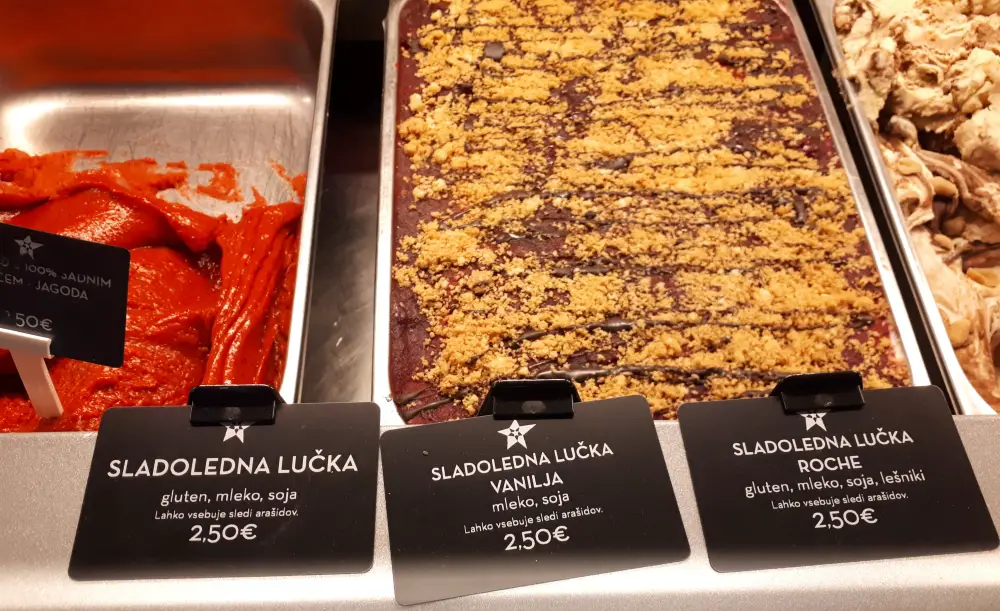
Photo: JL Flanner
Back to the topThings to do with children
You can find our Top 12 list of things to do with kids in Ljubljana here. If want to read more about the philosophy behind the wonderful House of Experiments look here, while our trip to the Museum of Illusions is documented here, and there’s always riverside walks, pizza and ice cream. With regard to the latter, take a look at our guide to six places that serve good ice cream in winter.
Mini Teater Ljubljana – The season sees a lot of puppet performances for children, in Slovene, at this theatre not far from Križanke. The English schedule for the month is here.
Ljubljana Puppet Theatre - The puppet theatre near the Central Market and next to the Castle funicular has a full programme or shows, for children and adults, with the schedule here. A sample of some of the shows from several years ago is below.
Back to the topLGBT+ Ljubljana
If you want to learn more about Ljubljana Pride, then take a look at our interview with its president here. If you're looking for more general links on "gay Slovenia", including a history of the scene and various projects, then you can find that here, while our stories about the community can be found here.
Klub Monokel – This lesbian bar in Metelkova is open every Friday, and this week on Thursday there's also Druga redna skupščina, while on Saturday night it's open as a bar again.
Klub Tiffany – And the gay bar next door is also open on Fridays, while every Monday until June 2019 there's tango at 18:00. On Thursday, 20:00, there's Kavarniški večer: Rave.
Pritličje – This seems to be the only "always open" LGBT-friendly cafe / bar / events space in town, and perhaps the country, so it's a good thing it's such a good one, open from morning to night, and with fliers and posters letting you know what's happening outside the narrow confines of, say, a general interest online what's on... guide.
Back to the top
Screenshot from Google Maps, showing the location of the Castle vineyard
Back to the topLjubljana Castle
The city’s main attraction is said to be the top tourist draw in the country overall, and to my mind it earns a spot near the top just for the history and views. But beyond that the current owners, the City of Ljubljana, have laid out a varied, interesting and enjoyable programme of events, one that rewards regular revisits.
I try and get up there every Saturday morning to clear my head and move my feet on the trails, and never tire of that end of the hill. At the other end, where the Castle sits, there’s a lot more than fresh air on offer. There are guided tours, restaurants, a café, Castle museum, puppet museum, a Watchtower you can climb to the highest point in the city, art shows, dances, live music, movies under the stars, festival days and more – enough to reward multiple trips up the hill through the year. All of these activities and events can be found on the Castle website, while on TSN you can see “25 things to know about Ljubljana Castle” here, and “Ten Ways to Enjoy Ljubljana Castle” here.
Back to the topMuseums & Galleries
Most public galleries and museums are closed on Mondays, although not the National Museum, and - as noted at the start
Plečnik's desk. Photo: JL Flanner
Plečnik’s House is worth a visit if you want to learn more about the architect who gave Ljubljana much of its character. Read about our guided tour here.
Cankerjev dom – On until February 28 is the exhibition Ivan Cankar and Europe, Between Shakespeare and Kafka, while until March 10 there’s a photographic show on the Ljubljanica, with images of the city’s river captured by Bojan Velikonja. Showing until the end of March is a selection of specimens from The Newspaper Museum.
City Museum – The Museum in French Revolution Square also has an exhibition on the writer Ivan Cankar that’s on until the end of February 2019, with pictures, books and manuscripts, all presented in Slovene and English. It also has a very interesting permanent exhibition on the history of Ljubljana, from prehistoric times to the present day, with many artefacts, models and so on that bring the story alive.You can read about my visit here. Until March 2019 there's a show highlighting the work Elza Kastl Obereigner (1884-1973), a pioneer Slovenian sculptress, with an example of her work shown below.

Photo: M Paternoster
The Faces of Ljubljana in the City Museum. Photo: JL Flanner
Galerija Jakopič – On until March 3 is Over My Eyes (Na moje oči), an exhibition of photographs from Iraq taken by Iraqi photographers.
International Centre of Graphic Arts – Running from Friday until March 3 2019 there will be a show of posters from Milton Glaser, while paintings, drawings, prints and from Nathalie Du Pasquier in a show called Fair Game. The latter is being promoted with the following image.

MAO – The Museum of Architecture and Design has much of what you'd expect, and until March 25, 2019, has a show on Ljubljana and it's relation with water. Until February 24 visitors can enjoy Toasted Furniture, which presents some experiments with the reuse of plastic waste, and until February 28 there's a show on Oskar Kogoj and his chairs.
Moderna galerija – The main branch of this gallery, to be found near the entrance to Tivoli Park, has a good collection of modern art, as well a nice café in the basement. Running until March 31 is a major show on young Slovenian painters, Time Without Innocence – Recent Painting in Slovenia, where you’ll see works like the following. You can read about my visit here (I loved it).

Iva Tratnik, Mating Season Totalitarianism, 2014, oil on canvas, 210 x 194 cm
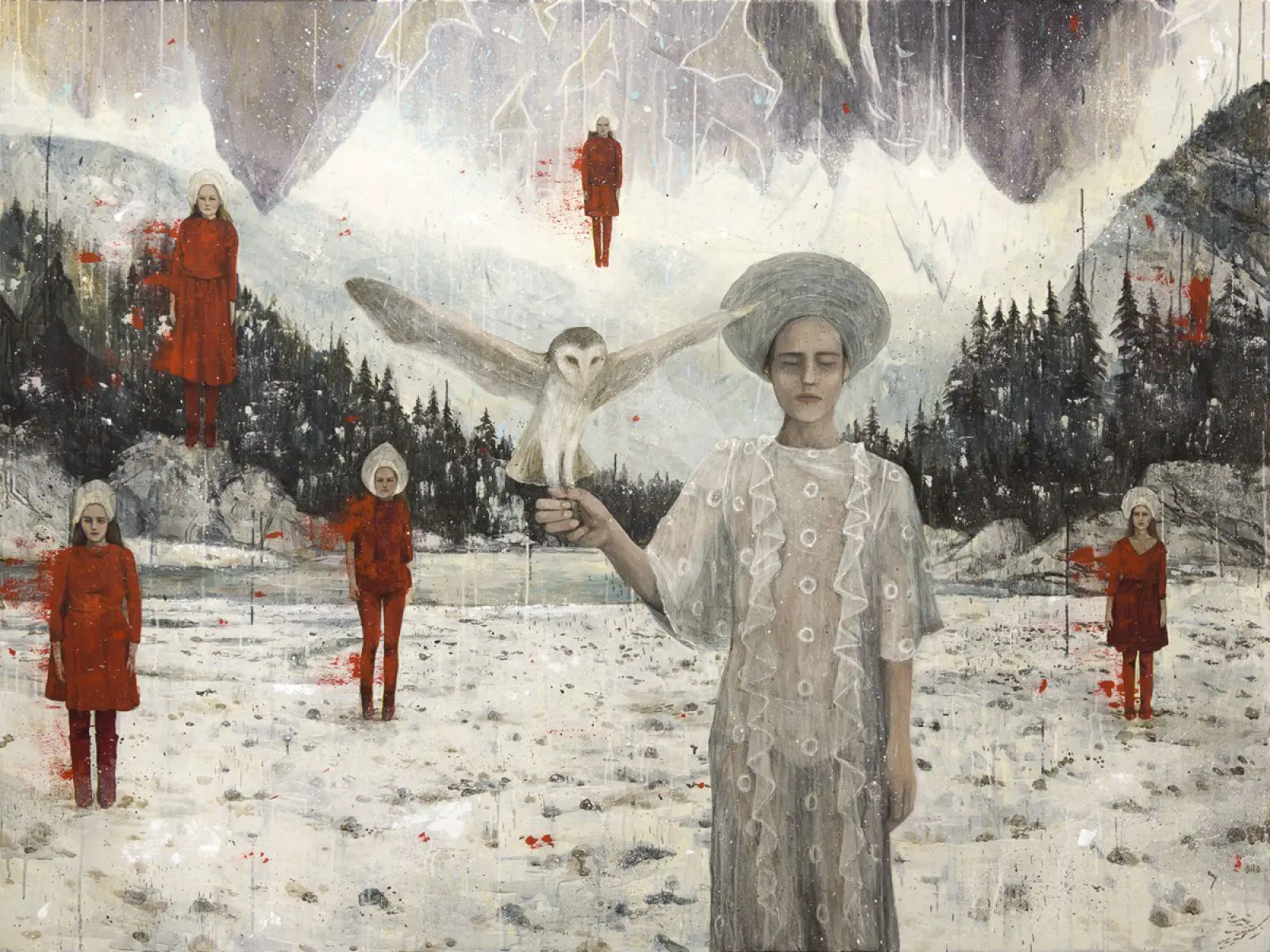
Tina Dobrajc, The Balkan Saga II, 2017, acrylic on canvas, 200 x 150 cm
National Gallery – The country’s main gallery has “the best” of what’s on offer from the Middle Ages to non-contemporary modern visual arts, and is in a great location for exploring other areas, just by Tivoli Park and opposite the main branch of the Moderna galerija. Running until February 10 2019 is a show called Ivana Kobilca (1861-1926): But Of Course, Painting Is Something Beautiful!, featuring works like the one below. You can read about our visit to the room containing sacred art from the Middle Ages here, and see a picture from our trip after the two girls.
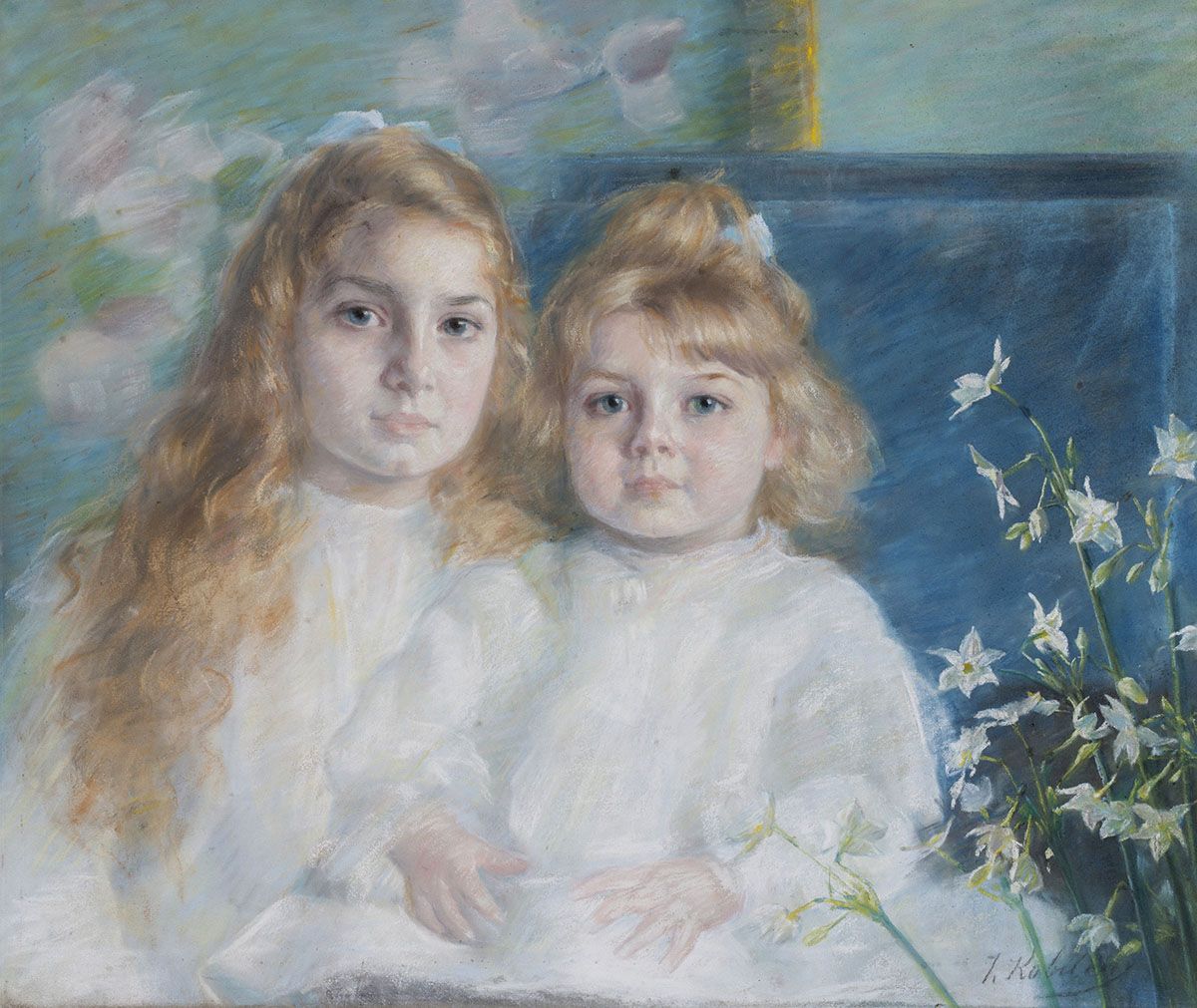

JL Flanner
National Museum of Slovenia – There’s plenty to see in the permanent collection here, from Roman times, Egypt and more, with the big draw this season being the exhibition of over 140 items of gold from Ming Dynasty China, as reported here, and with an example below. This runs until February 15th.

Photo: Wang Wei Chang
Meanwhile, the museum's Metelkova branch, located between one branch of the Moderna galerija and the Ethnographic Museum has some rooms on Church art, furniture and weapons, with the latter including more guns than you'll see anywhere else in town, and quite a thrill if coming from a nation where such objects are not household items.
Natural History Museum – On until the end of June 2019 is Our Little Big Sea, which takes a look at the oceans.
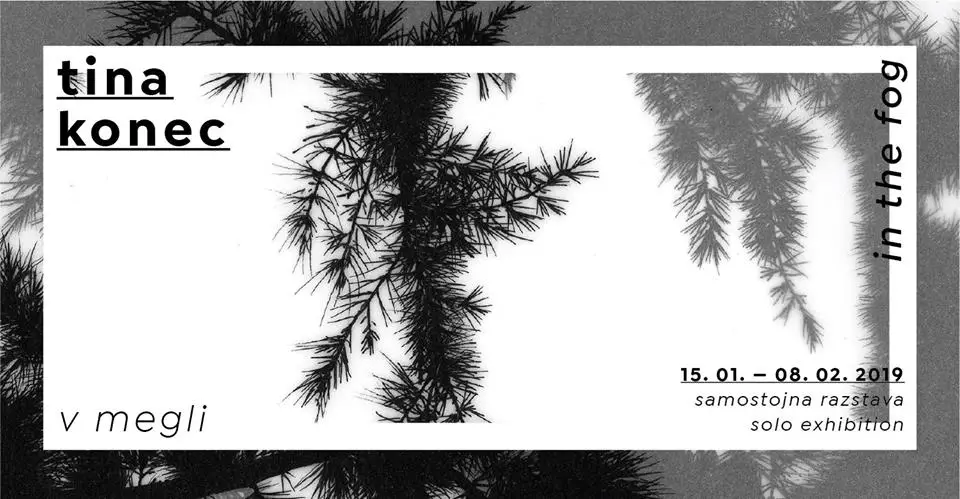
Ravnikar Gallery Space – Tina Konec has a show here until February 8, v megli (In the Fog).
Slovene Ethnographic Museum – The museum currently has a temporary show on Bees and Beekeeping, on until June 16 2019, as well two permanent exhibitions. One of these is called Between Nature and Culture, and has a great collection of objects from Slovenia and around the world, well worth the trip up to the third floor to see it (as recounted here). This place is located near the newer branch of the Moderna galerija and Metelkova.
Union is "the Ljubljana beer", but now both it and Laško are owned by Heineken. There are many local brews on offer around town, though, if you want to explore IPAs, stouts, wheatbeers, sours and so on Photo: JL Flanner
Union Experience – The Ljubljana-based brewer has a museum showing the history of the company, with the ticket also including access to part of the factory and a few samples of the product. You can read about our visit here.
It's not a formal museum, but if you're interested in "Yugo-stalgia" then you'll enjoy a trip to Verba, a small, privately run space that's crammed with objects and pop culture items from the era, and is conveniently located at the start of one of the short walks to the castle. It's also a great place to take pictures, if you leave a donation, and you can read more about it here.

Verba. Photo: JL Flanner
Alternative Ljubljana isn't a museum or gallery, as such, but instead turns the city streets into a museum and gallery. Learn more about their tours of street art, history and LGBT Ljubljana here.

Photo: JL Flanner
Back to the topOther things to do in Ljubljana
If you'd like to spend an evening painting with others, then take a look at Design with Wine, which organises painting parties on Trubarjeva cesta,

If you want to see some antiques, then check out the wonderful Antika Carniola, as discussed here. The man behind it, Jaka Prijatelj, has a fine eye for life on this street, as you can see on his Facebook account.
Photo: JL Flanner
If you’re in town and want to go jogging or walking in nature, why not take another look at the Castle, with a brief guide to the trails here. If you want something bigger, head to Tivoli Park.
And if you're bored with the Old Town, why not take a walk, cycle or boat ride to nearby Špica and enjoy the riverside life. Learn more about that here.

visitljubjana.si
![]()
maxpixel.net, public domain
Want to stretch and breath? Then check out our list of drop-in yoga classes for tourists, visitors and the uncommitted. If you're heading to the coast, check out our interview with a yoga teacher who offers breakfast sessions there, while if you're staying in town (or nearby) and want to try some "family yoga" then you can learn more about that here and maybe get your kids to calm down a moment or two.
There are some golf courses near Ljubljana, but even ones further away are not far, as seen in our list of all the golf courses in Slovenia. Note that these close when the snow starts, if it ever does this year, in which case you might be interested in what's new at Slovenia's ski resorts for 2019, as reported here.
![]()
Photo: maxpixel.net, public domain
Back to the topDaytrips
Most of Slovenia is only a few hours from Ljubljana, and you can easily visit Lake Bled, Lipica Stud Farm, Postojna Cave, Predjama Castle, the coast and other locations, while if you'd like to take a photo of from that bench in Bled, then you can learn how to get there here. If you’re looking for something more ambitious, then check out our recent guide to the 17 members of the Association of Historical Towns of Slovenia

Photo: Google Image Search
Back to the topGetting around
If you want to get a Ljubljana Tourist Card, which gives you travel on the city buses and entry to a lot of attractions, then you can read more about that here, and if you want to use the bike share system, as useful for visitors as it is for residents, then you can learn more by clicking this. Visitors with reduced mobility will be pleased to find that downtown Ljubljana is generally rated as good with regard to accessibility, and that there’s a free, city-sponsored app called Ljubljana by Wheelchair highlighting cafés, attractions and so on with ramps, disabled bathrooms and Eurokey facilities, which you can read about and download here. Manual wheelchair users can also borrow, for free, an attachment that will motorise their equipment, as reported here.

Screenshot from a Twitter video
If you’re driving into town and don’t know where to part, our guide to how to park in Ljubljana is here.
There aren't many places to eat after midnight, and most of them are by the train station, as reported here.
Want / need cigarettes but the stores have closed? Here's an incomplete list of bars downtown that will satisfy your craving for the demon weed. While if you’re having trouble with the ATMs then here’s a guide to the Slovene you’ll see on screen. If you get a hangover then find out where to get paracetamol (and prescription drugs) in Ljubljana here, while details on emergency birth control can be found here.
Ljubljana is a small and relatively safe city, but if need to contact the police then there’s a special number for foreigners, and that’s 113.
Back to the topSTA, 30 January 2019 - Agriculture Minister Aleksandra Pivec has backed efforts by winegrowers from the Slovenian region of Brda to protect the Rebula wine together with fellow Italian winemakers across the border.
The Rebula vine is grown on some 25% of all vineyards in Brda, a region near the city of Nova Gorica on the border with Italy.
The Rebula wine is thus synonymous with Brda and is also grown on the Italian side of the hilly Brda.
What bothers the Slovenian farmers is that Italian winegrowers from the Padua Valley also grow this vine.
But due to a different climate, the same vine produces a different wine taste, wine company Klet Brda director Silvan Peršolja explained on Wednesday.
Growing Rebula in Brda is much harder than in the valley, where it is planted in sand as opposed to a marl-rich soil on the hills of Brda and in the Vipava Valley in Slovenia.
"We also kept Rebula when Chardonnays, various Pinots and other varieties of wine dominated the market," said Peršolja.
Now that Rebula is gaining ground globally, there are some who have never known Rebula in their entire lives who would like to take advantage of it, he said.
"The Rebula from low-lying areas does not reach the quality of the Rebula from Brda, what they have in common is only the name," said Igor Simčič, one of the leading winegrowers from Brda.
The winegrowers from Slovenia's Brda thus launched a debate with their colleagues from the Italian side of Brda to protect Rebula at the international level a few years ago.
However, protection procedures are rather long and it could already be too late in a few years' time, so prompt action should be taken, the farmers told Pivec.
The minister pledged her support for their efforts to join forces with the winegrowers from the Italian side of Brda.
She visited Brda to discuss various challenges faced by the local winegrowers and other farmers, including more efficient drawing of EU funds, where the farmers highlighted red tape as the biggest problem.



